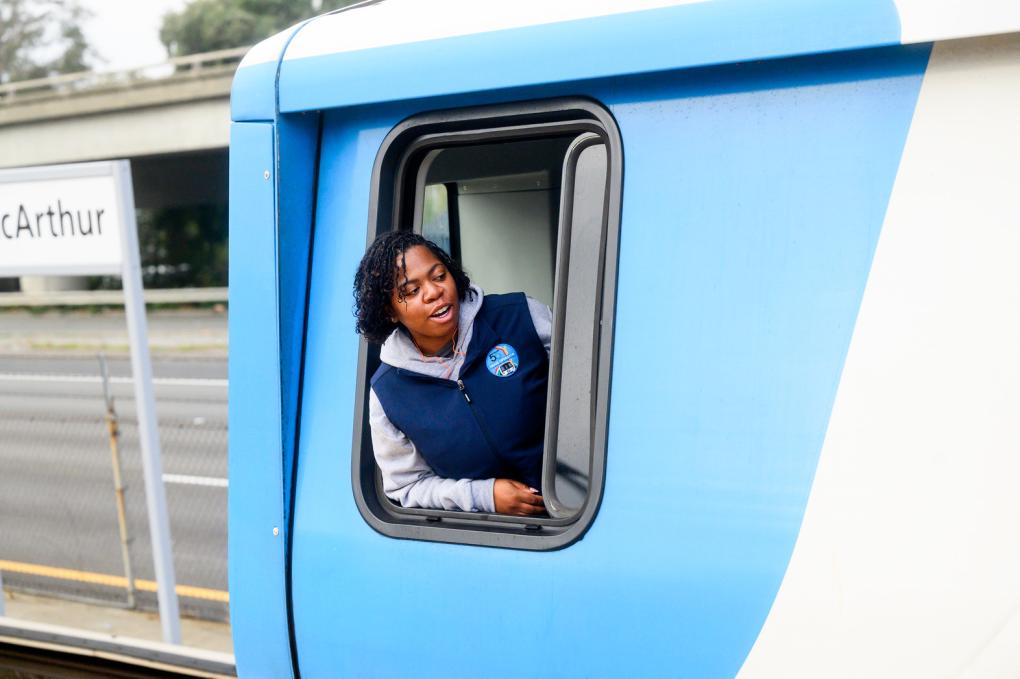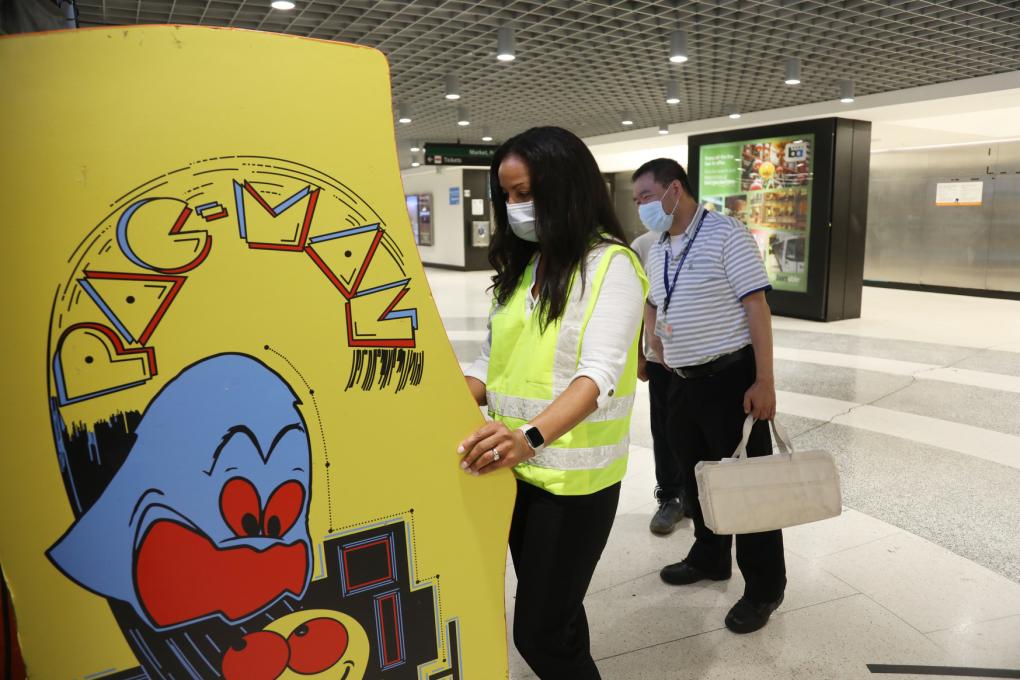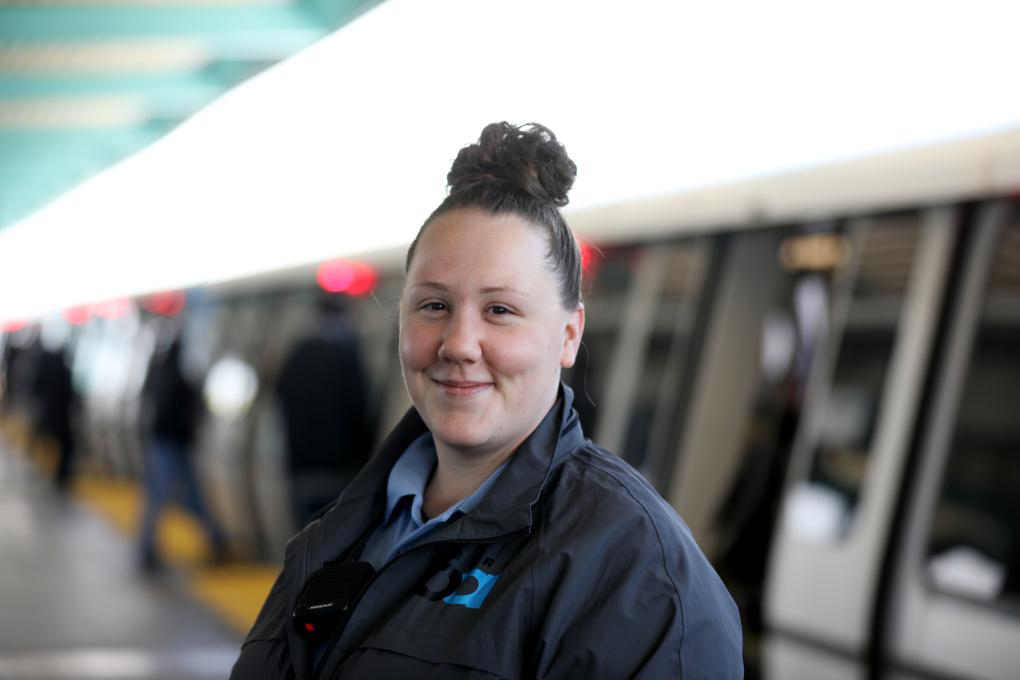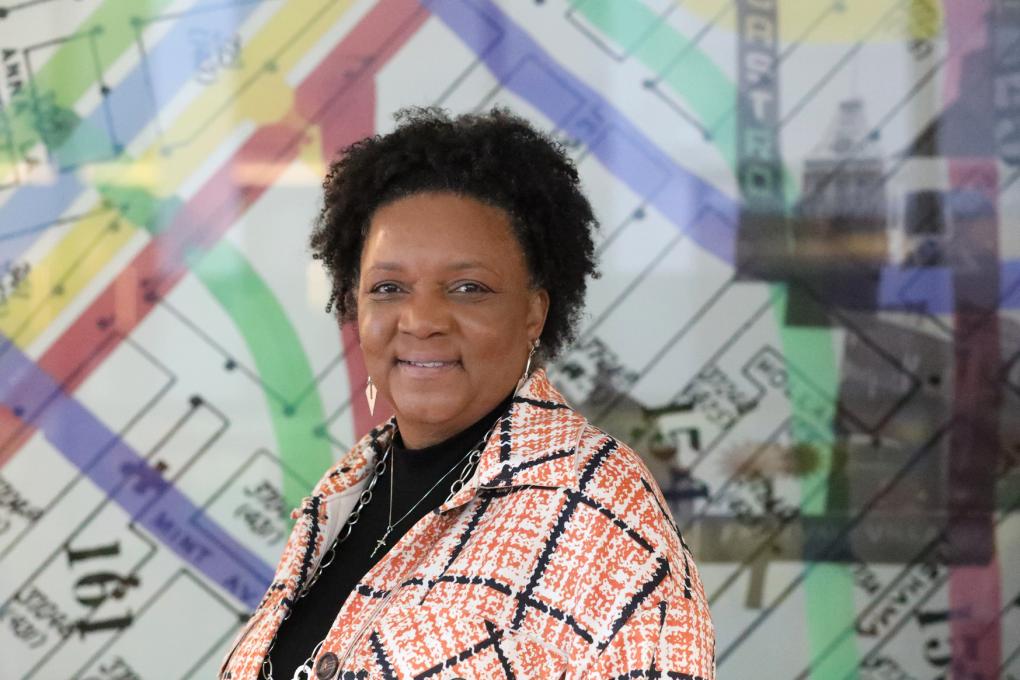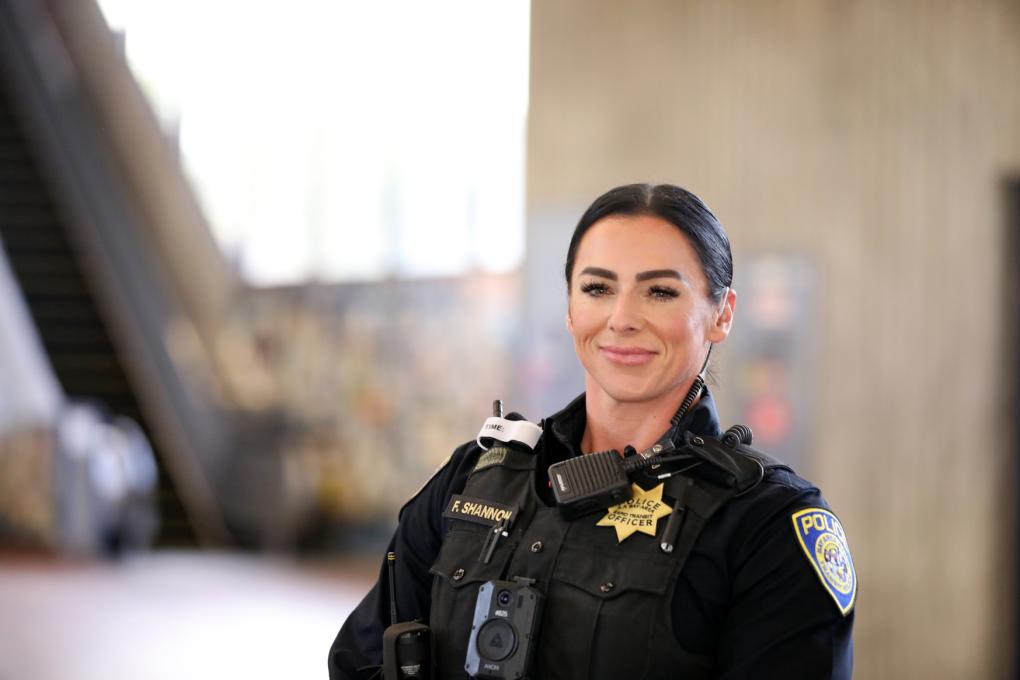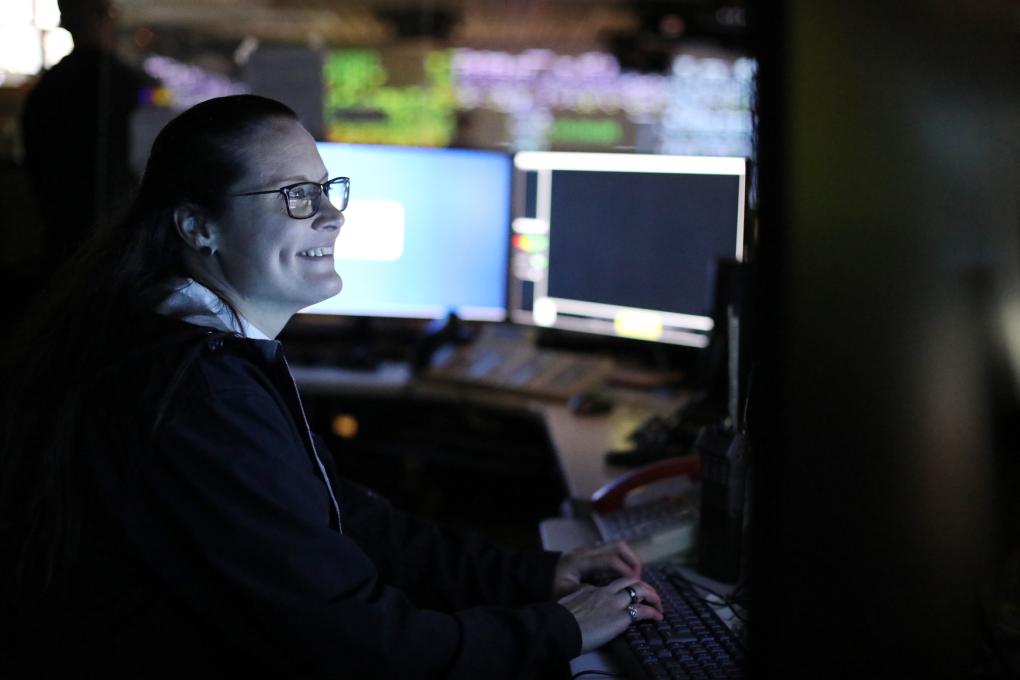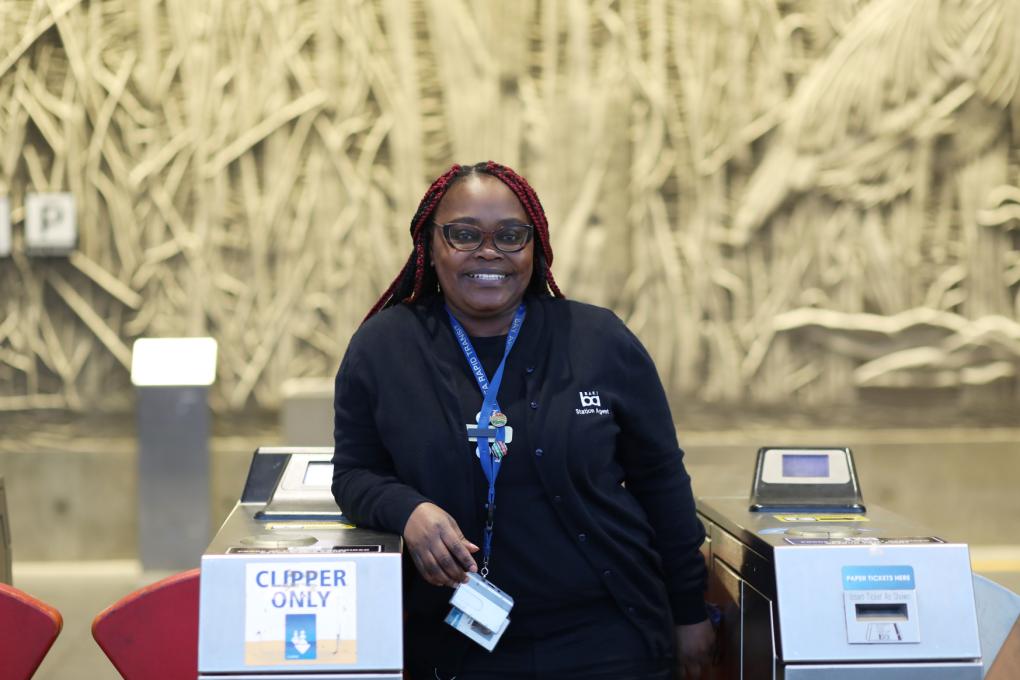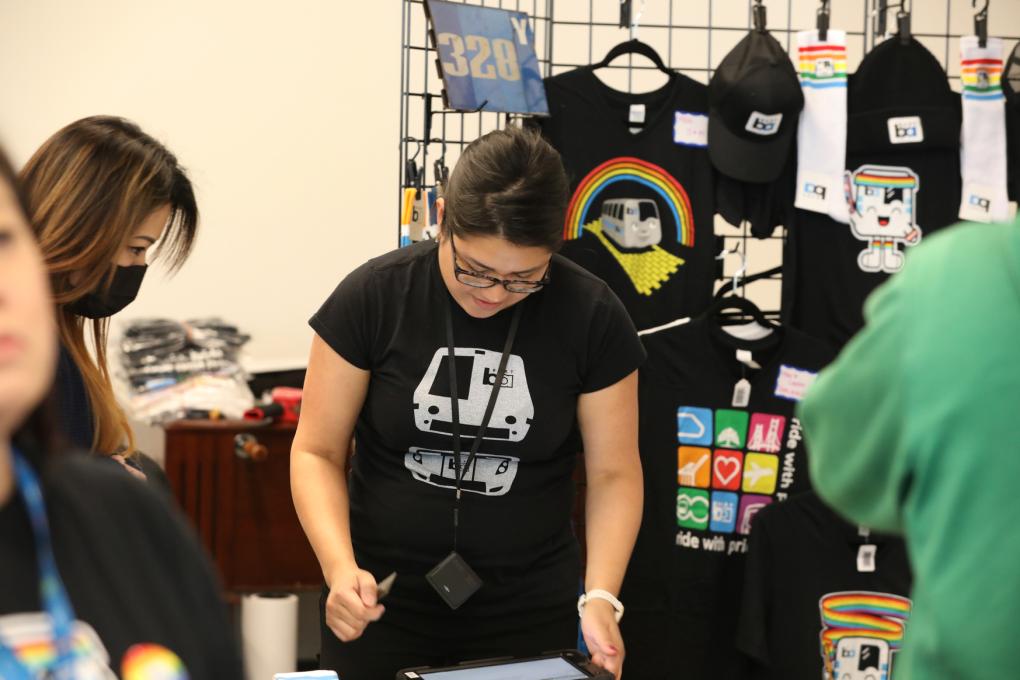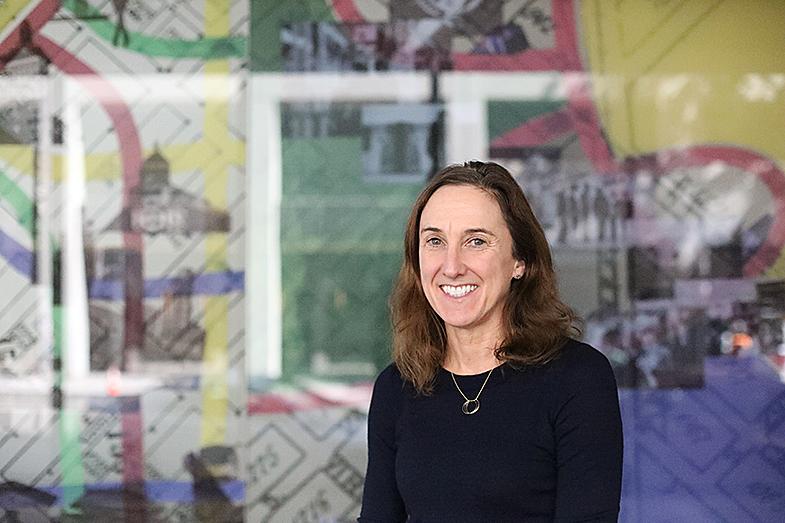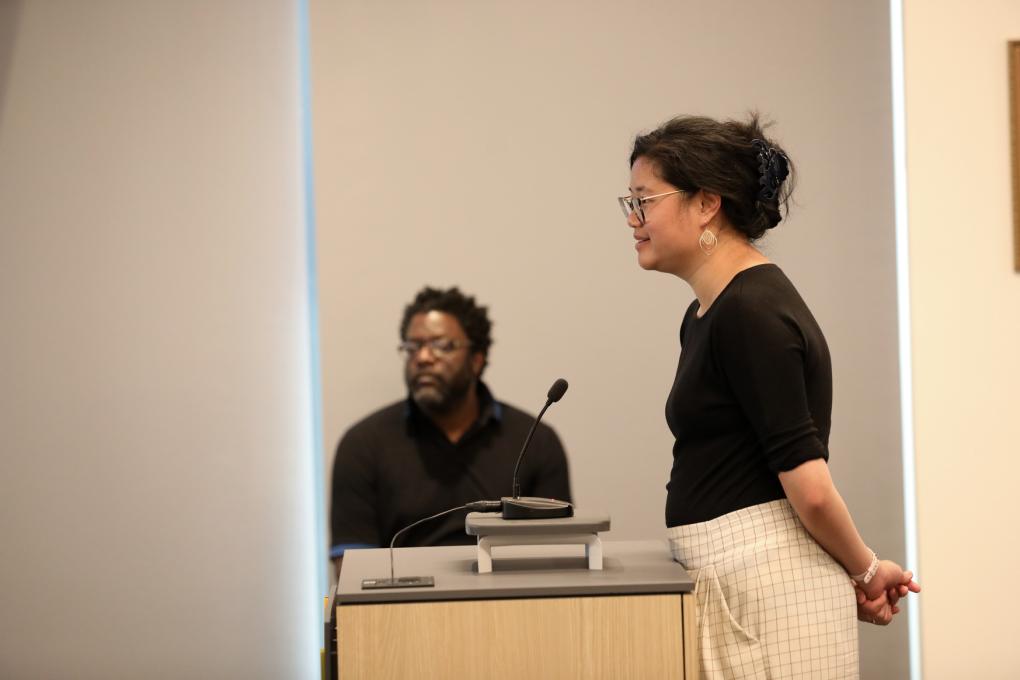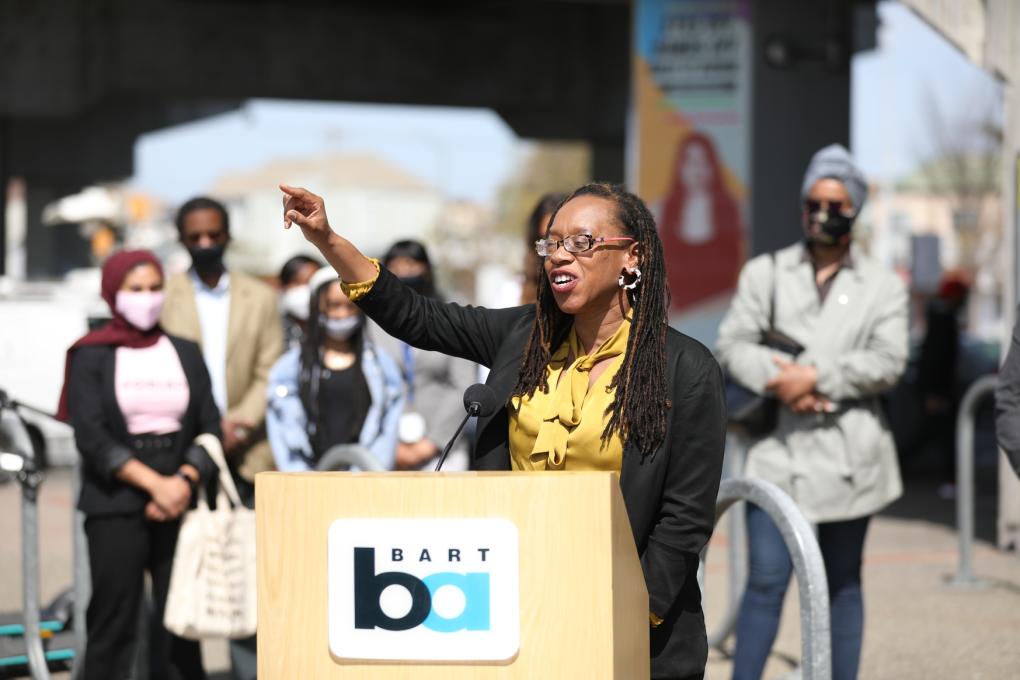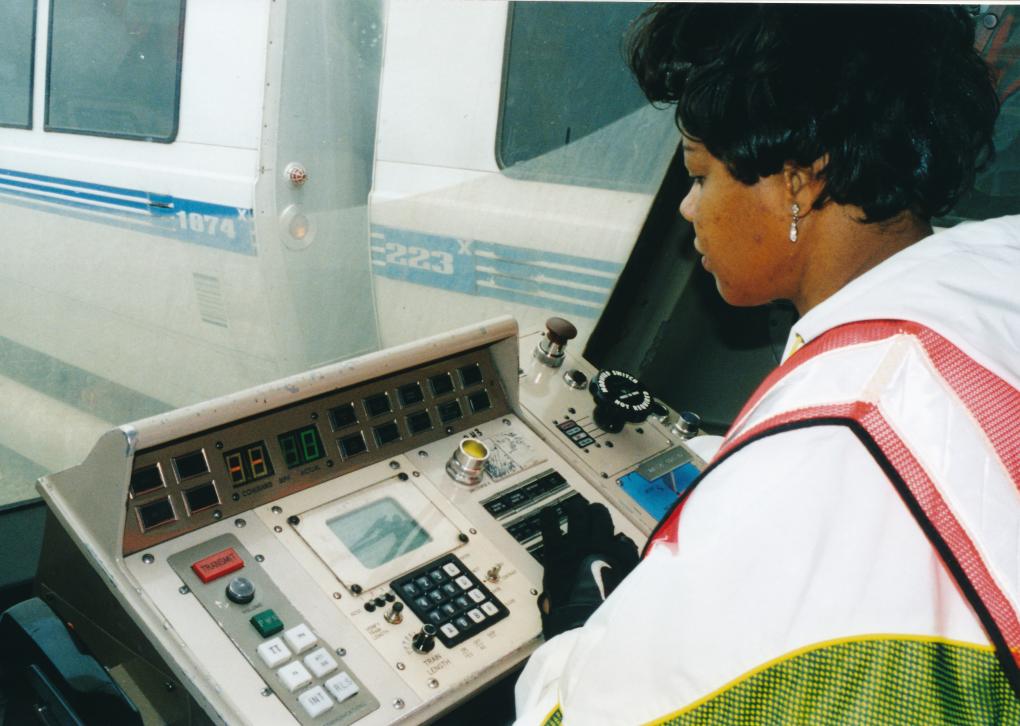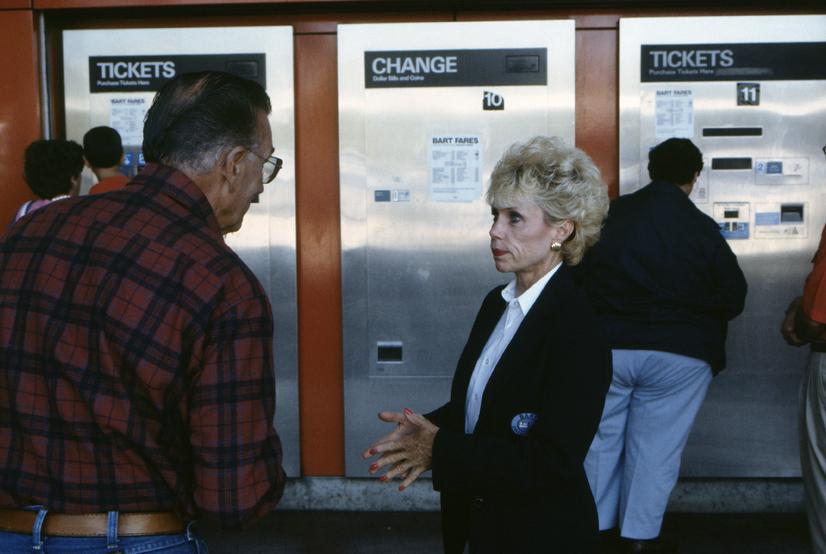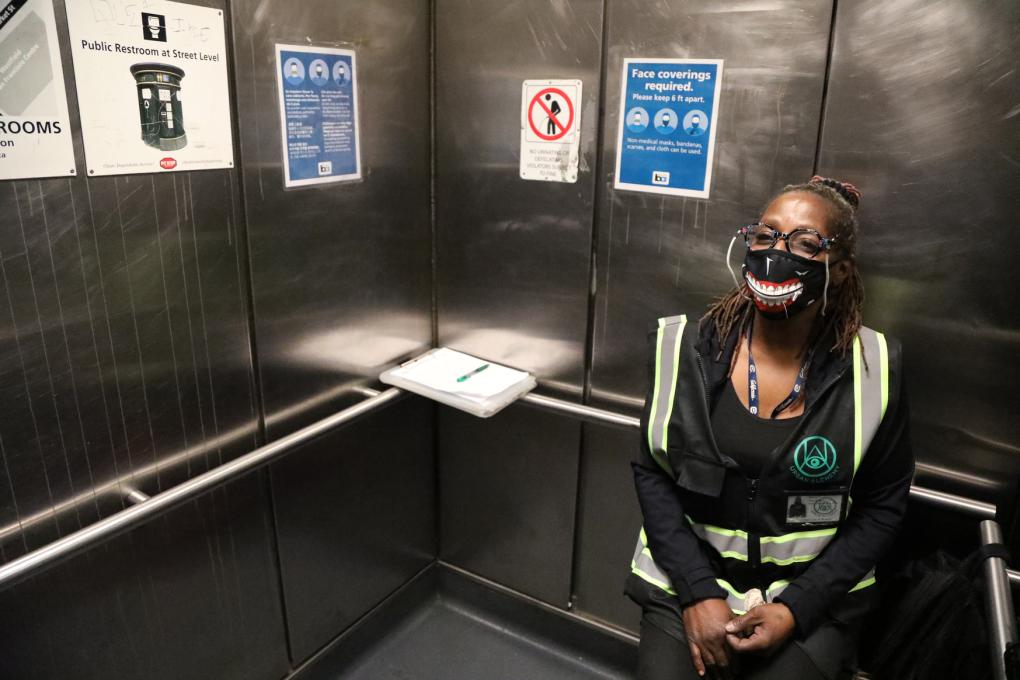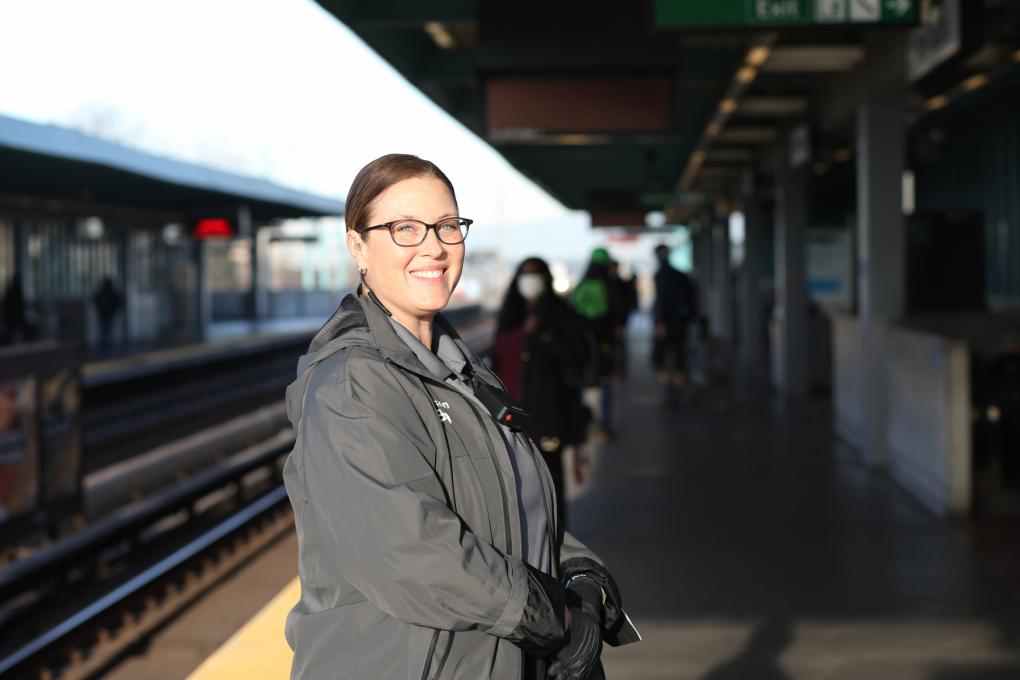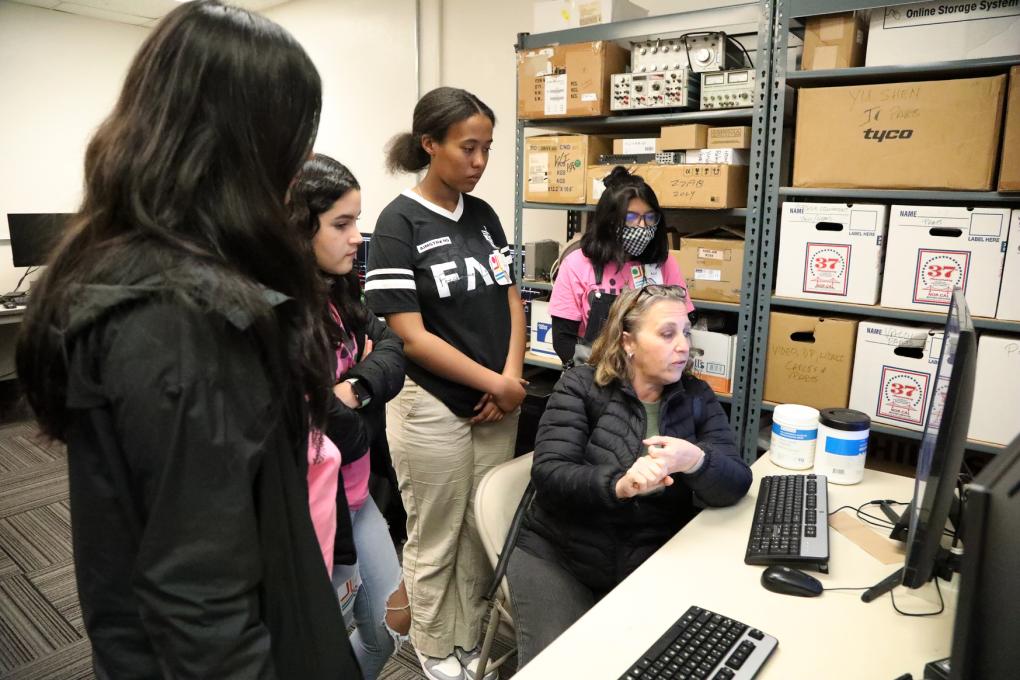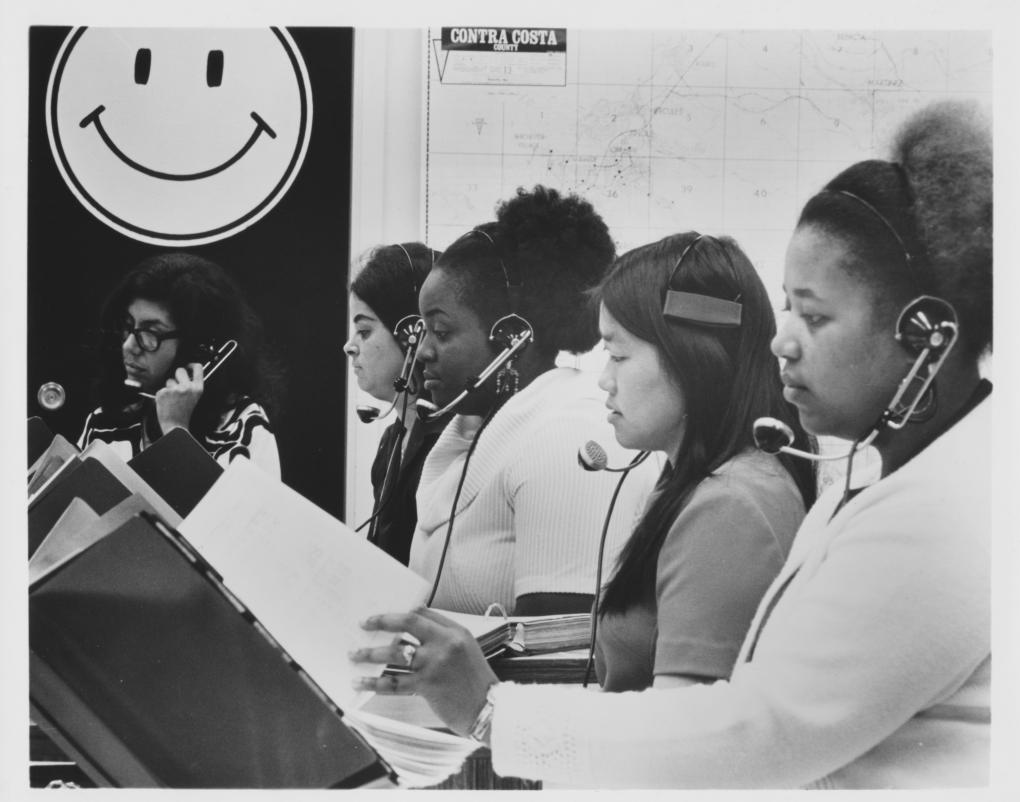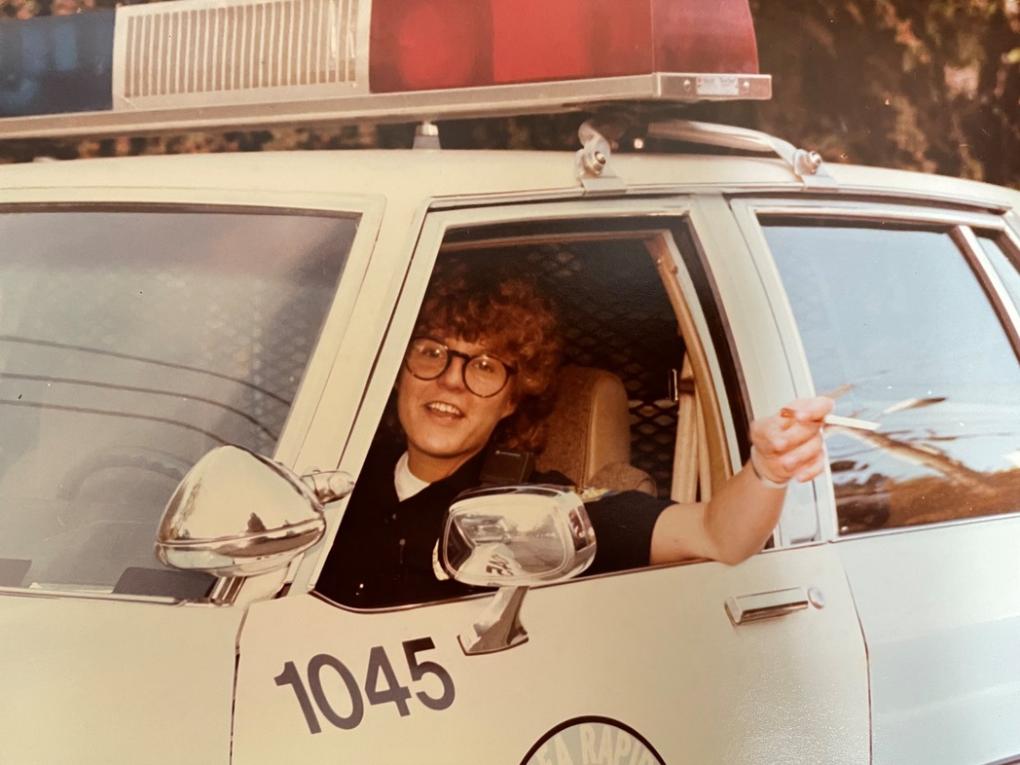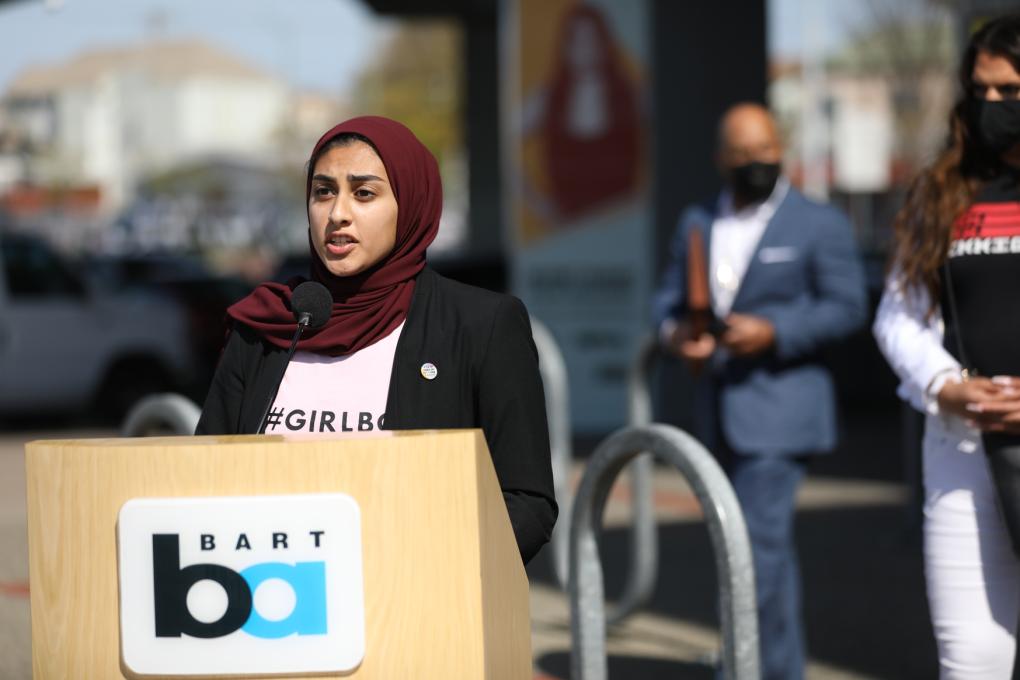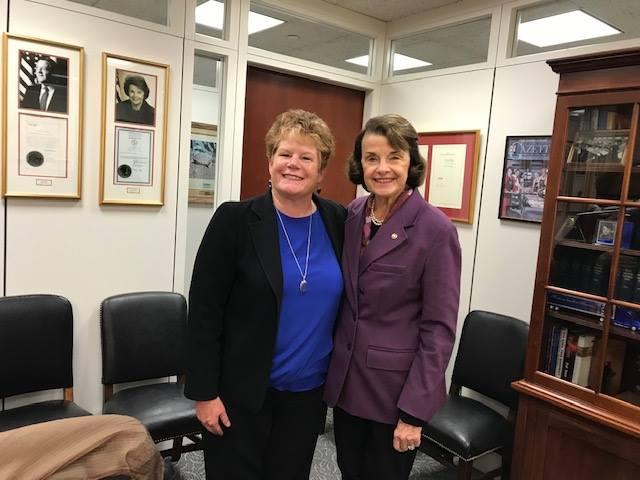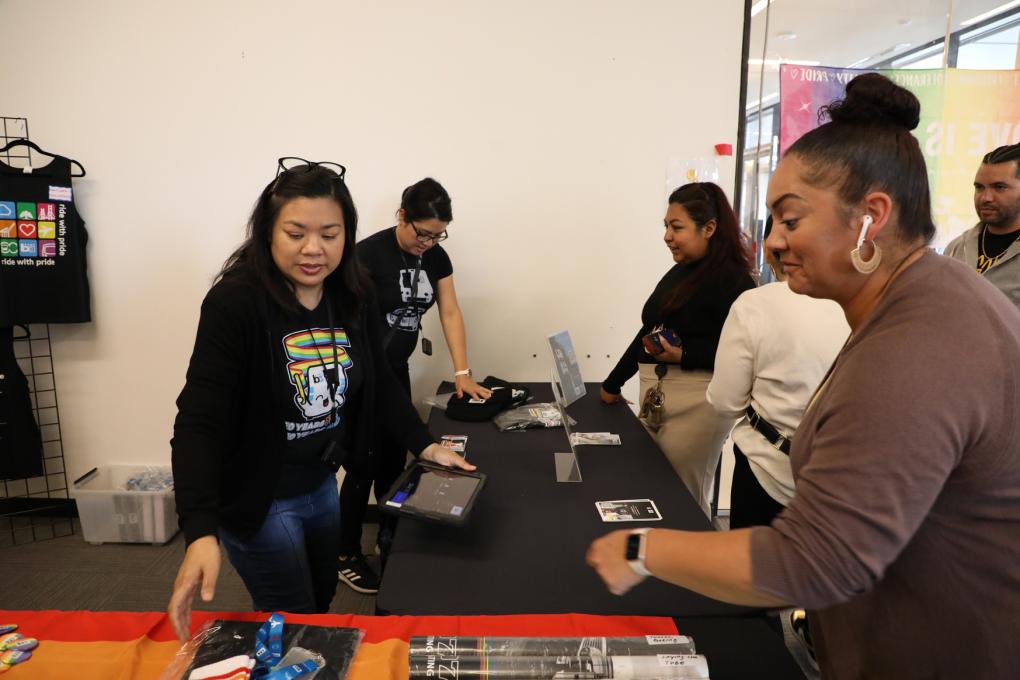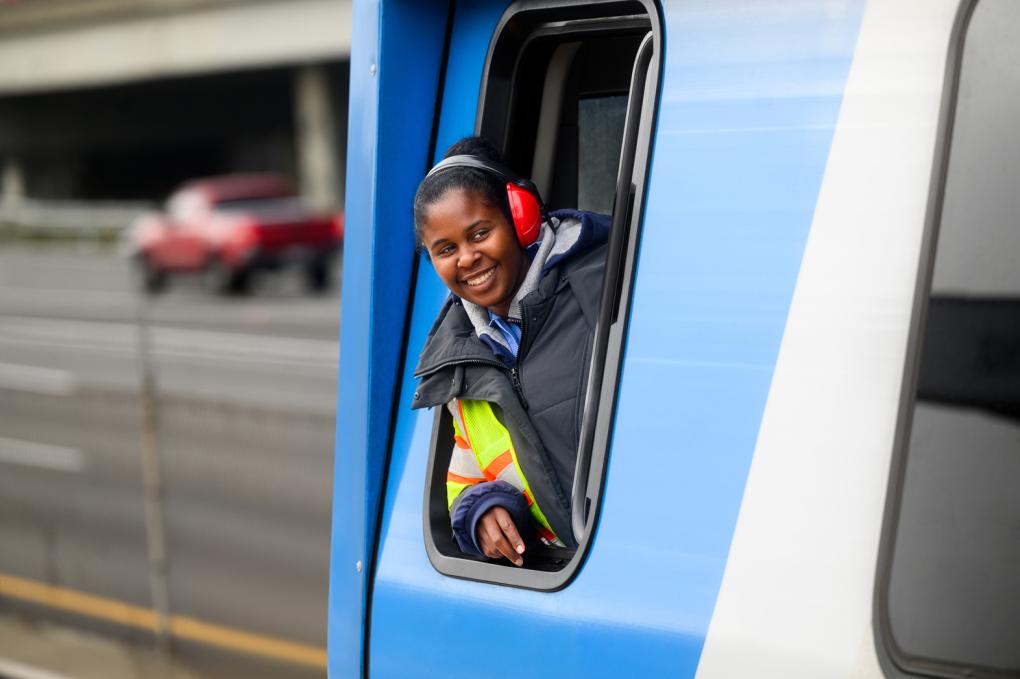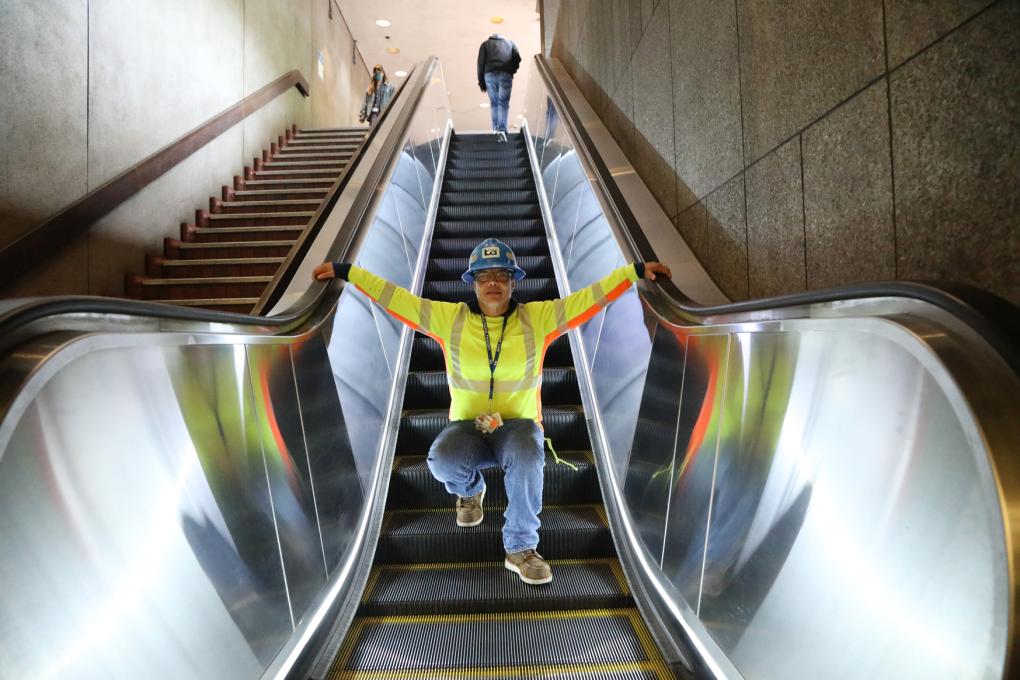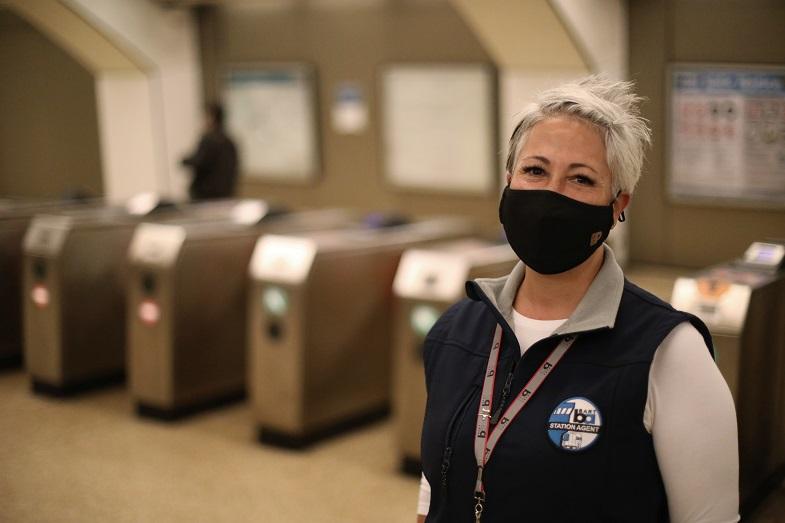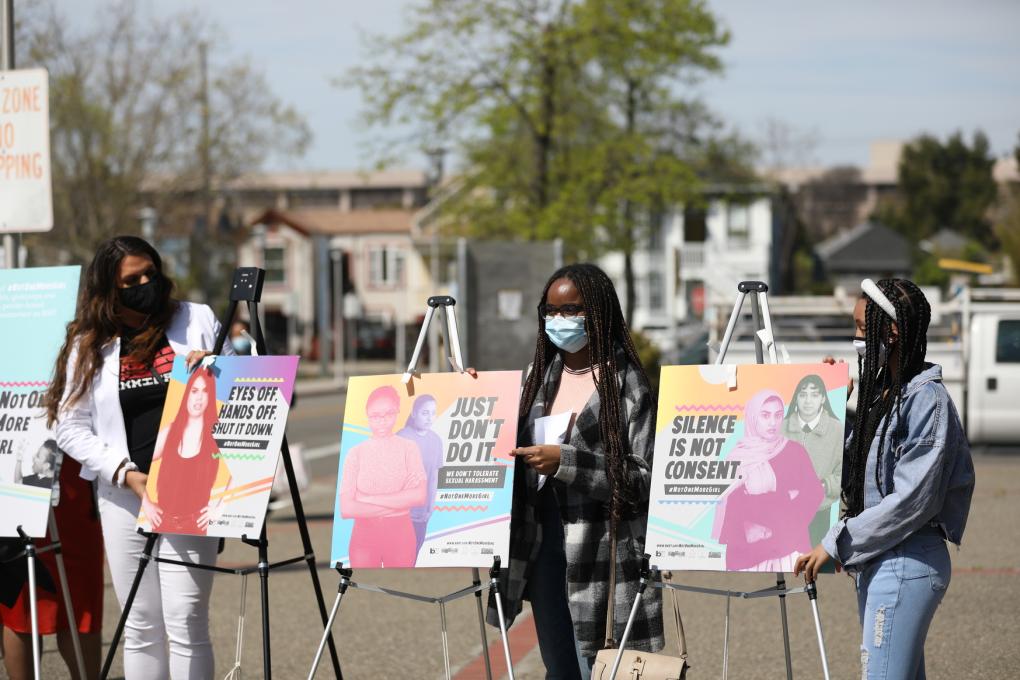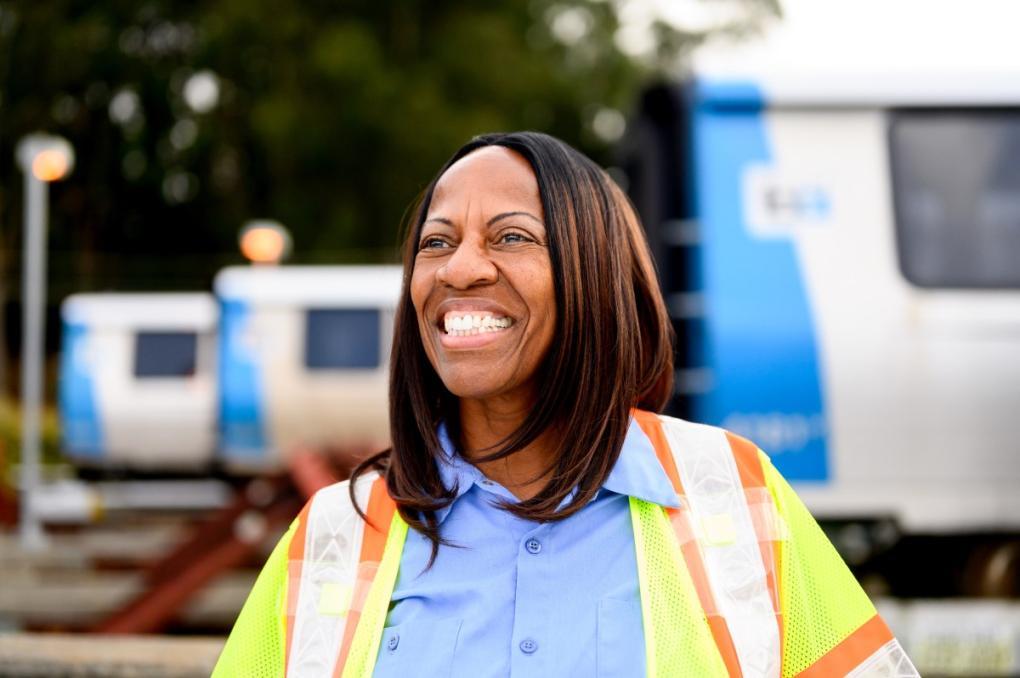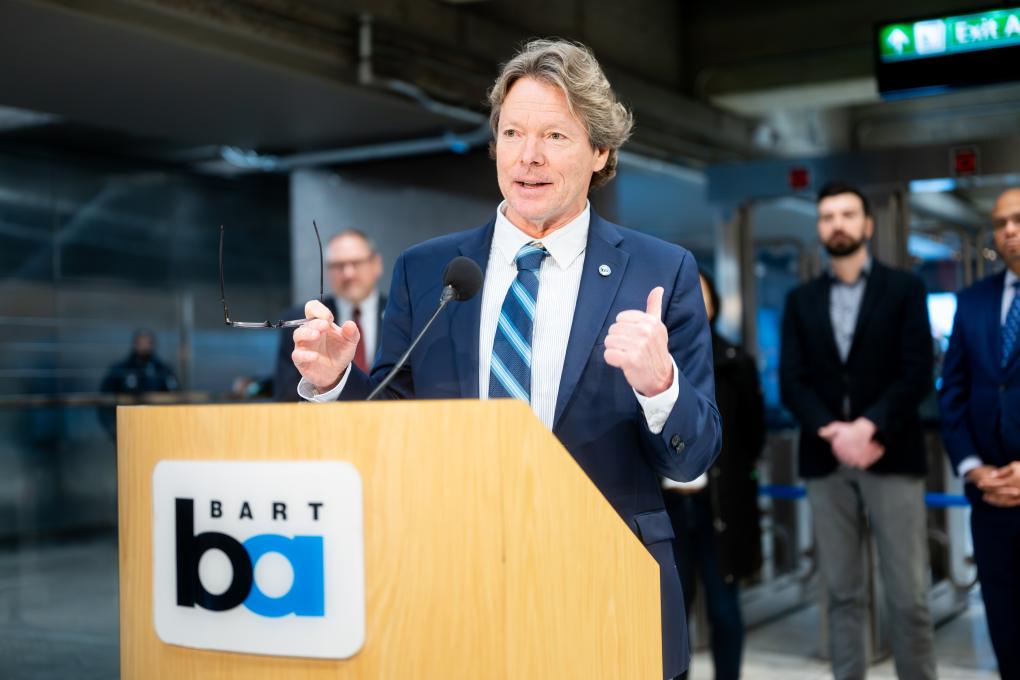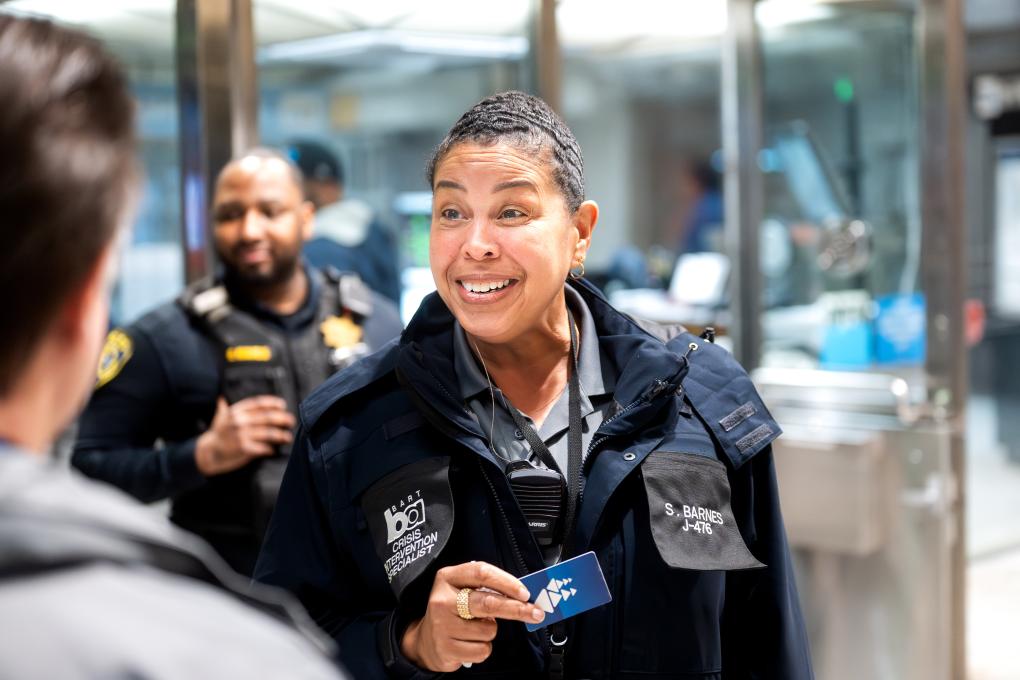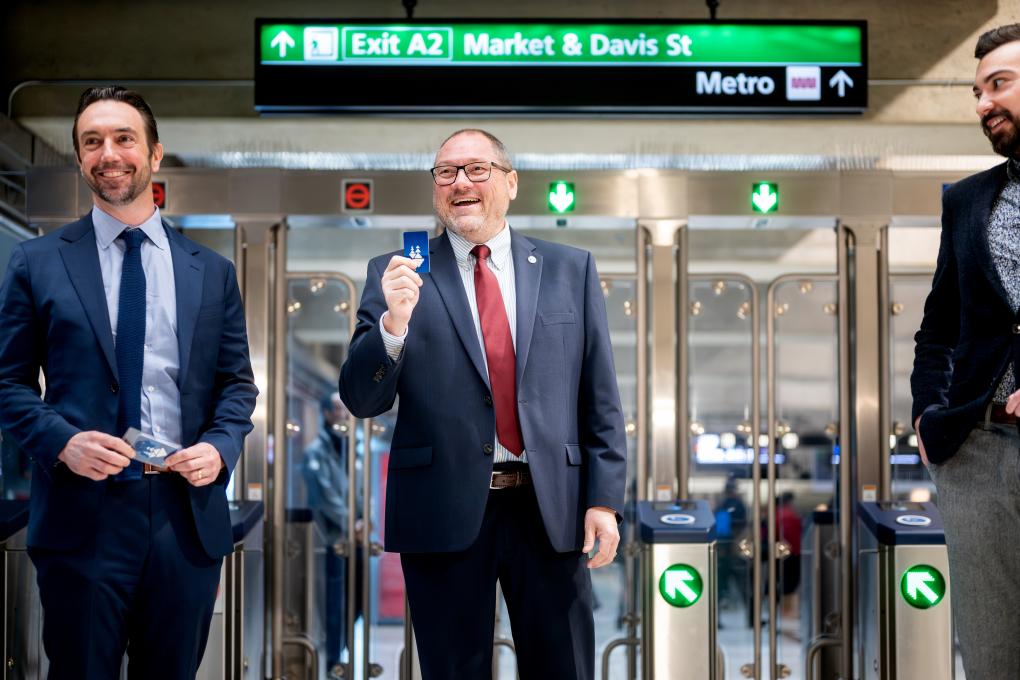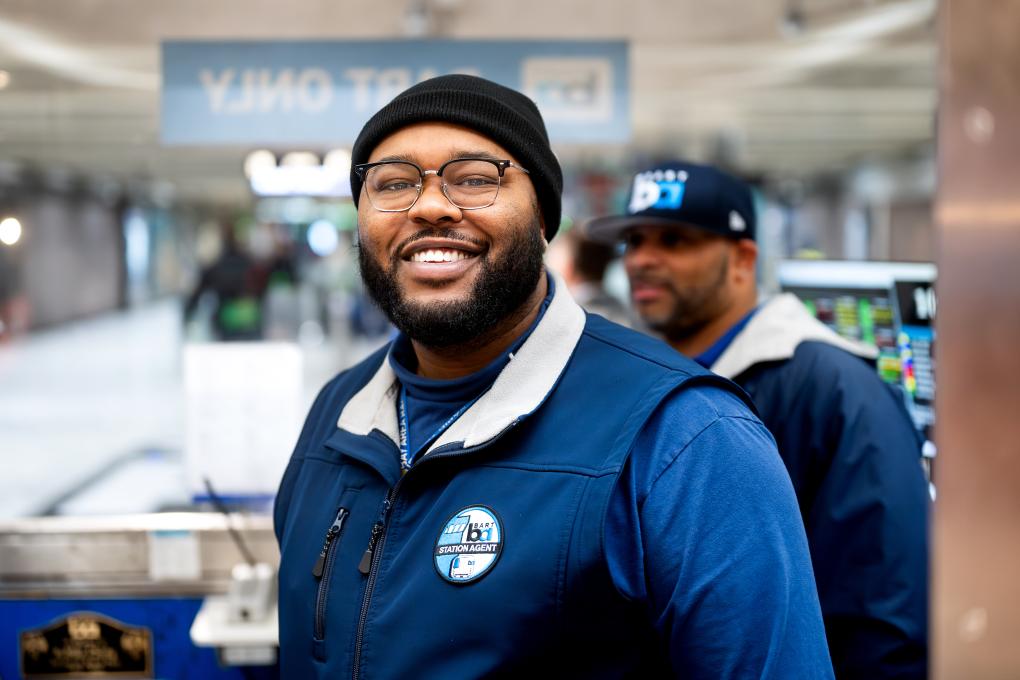Search Results
BART avoids service cuts for one more year with balanced budget while facing historic deficits without new revenue
The BART Board of Directors voted to adopt a balanced budget for FY26, protecting safe, clean, and frequent service for one more year before facing a fiscal cliff in FY27 that could have dire and widespread impacts on the Bay Area's greater transportation network. The BART board continued its strategy of avoiding service cuts by using the remaining $318 million of state and regional emergency funds to help pay for the cost of running train service, while supporting deficit-reducing, cost-cutting measures, such as a strategic hiring freeze and running shorter trains. A planned 6.2% fare increase, expected to go into effect January 1, 2026, also helps close a projected $35 million deficit.
The FY26 budget is also supported by a fiscal year-over-year 4% increase in paid trips thanks to new fare gates, new fare programs, such as Clipper BayPass offering employer-paid unlimited transit passes, attracting more riders with a cleaner, safer ride, and schedule coordination with connecting transit agencies.
BART’s overall expenses grew by less than 1% in FY26, demonstrating that cost controls and targeted cuts to non-labor expenses are holding costs down, as well as the effectiveness of BART’s disciplined approach to belt tightening and prudent fiscal management. No new positions were added to the budget and dozens were frozen in a strategic hiring freeze.
“Our riders are noticing the improvements we have made to the overall BART experience, resulting in the highest satisfaction rates in ten years,” said BART Board President Mark Foley. “We made strategic decisions in this budget to show the Bay Area we must be part of the solution in reducing costs, but also ensuring we have frequent, clean, and safe service at this critical moment when traffic congestion is increasing and people are returning to the office and wanting to take car-free trips on nights and weekends as well.”
Operating budget prioritizes Safe and Clean Plan
BART’s $1.2 billion operating budget will continue to fund the current service plan with no planned cuts to service this fiscal year. In August, small adjustments will be made to BART’s schedule in coordination with other transit systems to improve timed transfers with Caltrain at Millbrae Station and to improve transfers with Wheels Bus service at Dublin Station. Improvements to the BART to Antioch transfer are also planned.
While the FY26 operating budget includes $35 million in reductions and cost controls, these cuts will not impact BART’s ability to provide clean and safe service or impact BART’s efforts to have an increased safety presence on trains and inside stations.
Capital budget prioritizes reliability improvements and modernization efforts
BART’s $1.1 billion capital budget prioritizes funding Fleet of the Future rail cars, BART’s project to upgrade its aged train control system to a modern Communications Based Train Control System, new traction power equipment which will improve reliability, new escalators, a new BART Police headquarters, and other rebuilding efforts. 98% of the capital investments are allocated to system reinvestment and service and capacity enhancements that will allow us to continue to serve as the backbone of the region’s transportation system. These projects are funded by voter-approved Measure RR and other local, regional, state, and federal grant sources, in addition to allocations from BART’s operating budget to help pay for these essential projects.
Fiscal cliff is rapidly approaching
The FY27 preliminary budget, which includes no emergency assistance, shows a $376 million deficit due to BART’s outdated funding model and the fact the Bay Area has embraced remote work at higher rates compared to the rest of the country. The BART Board has voted to support SB 63 (Wiener/Arreguin), also known as the Connect Bay Area Act, which would authorize a regional transportation funding measure on the November 2026 ballot to enact a sales tax in Alameda, Contra Costa, and San Francisco counties, with an option for San Mateo and Santa Clara counties to opt in. Funds from the measure would support transit agency operations and rider-focused transit coordination improvements.
BART is also advocating for state budget funding to prevent service cuts in FY27 as well as requesting that BART’s current funding allocations from state programs continue to be honored in the coming state budget, which is under development now.
BART releases body camera video of the November 18 officer-involved shooting at Union City Station, announces independent investigation
BART is releasing video of the officer-involved shooting that took place on Monday, November 18, 2024, in the Union City Station parking lot at around 9pm. Two BART Police officers stopped a vehicle driven by 32-year-old Jasmine Gao after receiving a report of reckless driving. Before contacting Ms. Gao, officers learned the vehicle’s registration was expired. During the stop, Ms. Gao displayed erratic behavior. When the officers asked her multiple times to exit her vehicle she did not comply. While an officer was reaching inside the car, Ms. Gao rolled up the window and accelerated forward. An officer fired three shots, striking Ms. Gao in the upper torso. Ms. Gao received immediate first aid and was transported to a nearby hospital, where she was treated and later discharged.
The case has been referred to the Alameda County District Attorney’s Office.
The officer who discharged his weapon is Nicholas Poblete. He has 6.5 years of service for BART Police and is assigned to the Operations Bureau. He has been placed on administrative leave.
BART’s Chief of Police Kevin Franklin made the following statement about the video and the investigation:
“BART is releasing the full, unedited body camera video from both responding officers, with only statutorily mandated redactions to provide full transparency and accountability in this unfortunate incident. I want to assure the public that all aspects of this incident will be thoroughly investigated. Due to the seriousness of this incident, we have retained an experienced third-party investigator to conduct the internal administrative investigation to ensure an unbiased and objective review. BART remains committed to continuous improvement and ensuring the actions of our police officers meet the highest of standards.”
BART’s Civilian Oversight Model
BART’s Civilian Oversight Model, adopted by the BART Board of Directors, offers additional layers of independent oversight of the BART Police Department. The Office of the Independent Police Auditor (OIPA) may accept and investigate any complaint of misconduct and may monitor and review investigations.
Women's History Month 2024: BART celebrates the trailblazing women who have shaped our world from past to present
Today, March 1, marks the beginning of Women’s History Month, a time to recognize and celebrate the vital role women have played – and continue to play – in American history, including the history of public transportation, which has been shaped and transformed by women.
BART is home to an amazingly diverse workforce with women serving in crucial roles across the agency, from trackworkers and train operators to executives and our Board of Directors, which is composed of a majority of women.
To spotlight just a few exceptional women in the BART family:
Tera Stokes-Hankins is the first woman to serve as Chief Transportation Officer at BART. Tera started as a part-time station agent in 1995 nearly fresh out of college. Since her hiring, she has been promoted six times! Tera says she is motivated to work hard each and every day because “if BART’s not running, that means people can’t get to an interview or an appointment or class. To get up every day and make sure we’re ready to go and putting our best foot forward – that keeps me going." Read more about Tera’s BART journey here.
Thu Nguyen, a track operator, came to the Bay Area a few years ago with her daughter and just $300 in her pocket. She didn’t have housing or a job, but she eventually landed at Cypress Mandela Training Center, which offers free pre-apprenticeship program for Bay Area residents and helps connect them with employment opportunities, including at BART. Foreworker Jaime Ramirez said Nguyen is “no holds barred.” He added: “She’s not afraid of the work. She just goes for it.” Read more about Thu here.
Stephine Barnes, a Crisis Intervention Specialist in BART’s Progressive Policing Bureau, recently won a Rider First Award in recognition of her work to move Bay Area transit forward. Stephine has worked for BART for more than two decades, and in her role as a CIS, she has changed the lives of many individuals. Her work has focused on reducing prison recidivism and advocating for those facing homelessness through intervention/prevention, de-escalation, case management, working with community partners, networking, and family reunification. Read more about Stephine here.

From left to right: Tera Stokes-Hankins, Thu Nguyen, and Stephine Barnes.
BART is committed to recognizing, supporting, and uplifting all the passionate and hardworking women in the BART family by fostering a culture that values diversity, equity, and inclusion – the themes of Women’s History Month 2024.
We thank every single one of the women at BART, who are working every day to make the system better for everyone.
Happy Women’s History Month!
BART's Holiday Toy Drive collects more than 1,100 toys and $3,600 for Mission Food Hub families
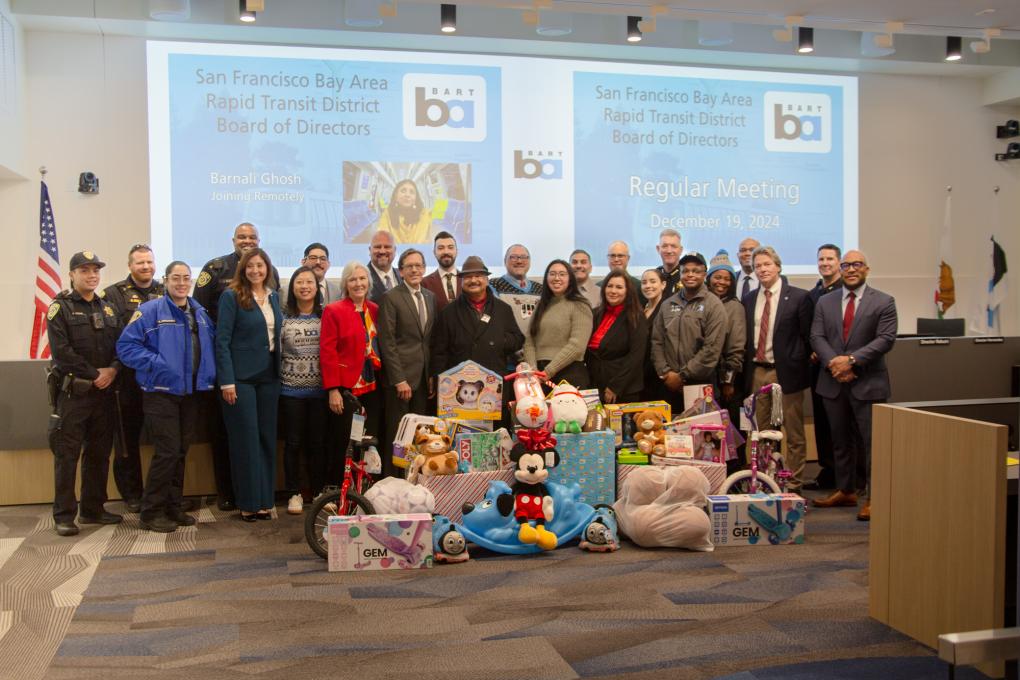
Members of the BART Board, BART executive staff, BART Police, OUTFRONT (BART's advertising partner), and CANA pose in front of some of the toys donated by BART for its 2024 Holiday Toy Drive.
Update: BART collected more than 1,100 toys and $3,600 in gift cards for Mission Food Hub families. More than 500 families attended the organization's recent toy giveaway, and each child was invited to select not just one toy, but two!
Each winter, BART hosts a holiday toy drive to give back to the diverse communities we serve. This year, we are honored to donate the toys to Mission Food Hub (MFH), a food bank that serves more than 300 families a week in San Francisco’s Mission District.
Mission Food Hub was founded in 2020 to provide nutritious, culturally appropriate groceries to families affected by the pandemic. Though the lockdown is over and most of the hub’s clients have returned to work, the need for groceries in the Mission’s Latino community remains, especially as the price of food continues to climb nationally.
Marisol and Otoniel Guillen's family of five relied on Mission Food Hub after the restaurant where Otoniel worked closed at the start of the pandemic. Now, Marisol, Otoniel, and their three children volunteer at the hub “to give back to the organization that gave to us,” said Marisol, speaking through a translator.
“This is my second family,” she said of the food hub. “It has been beautiful to see its impact on my friends, neighbors, and community.”
Mission Food Hub is under the umbrella of Cultura y Arte Nativa de las Americas (CANA), a 46-year-old organization whose objective is to educate people about the rich cultures and indigenous healing practices of the Americas and Caribbean. CANA is an outsize presence in the Mission – among other programs, it runs the San Francisco Lowrider Council, Somos Esenciales, Latin Jazz Youth Ensemble of San Francisco, and Carnaval San Francisco, the largest multicultural festival in California. BART has long been a Carnaval partner, and BART employees walk each year alongside the BARTmobile in the vibrant parade down 24th Street.
“We are grateful to have such a strong relationship with BART and to get to expand it with the toy drive this year,” said Rosine Garcia, Mission Food Hub Program Manager and Festival Coordinator for Carnaval. Many of CANA’s clients are transit-dependent and travel from across the city to access CANA events and opportunities.
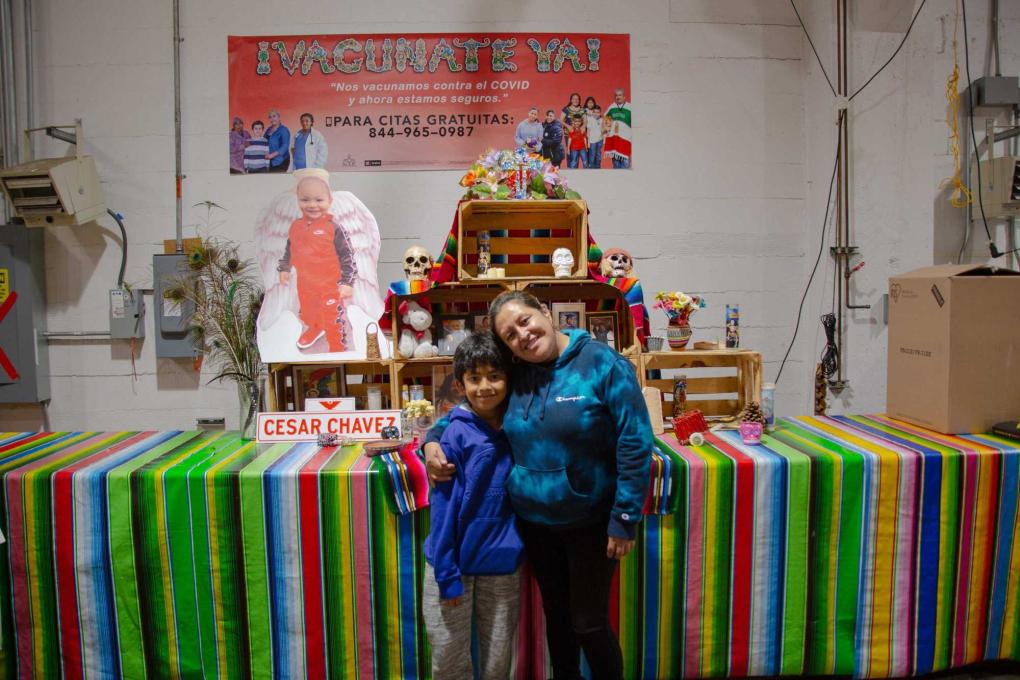
Marisol and her son in front of the altar at Mission Food Hub in San Francisco's Mission District.
BART’s annual Holiday Toy Drive is helmed by the Office of External Affairs and BART Police, who present the new, unwrapped toys and gift card donations in a joyful ceremony during the final BART Board meeting of the year. It’s tradition for the BART Board President to select the organization. Last year, BART employees donated more than 1,500 toys and $1,700 in gift cards to the Samoan Community Development Center of San Francisco (SCDC) and the Community Youth Center of San Francisco (CYC).
“Hardworking Mission families have been deeply affected by the pandemic, unstable housing, and business closures,” said BART Board President Bevan Dufty, who selected the recipient organization. “In a small, but important way, BART’s toy drive shows that we see these hardships and that we are fostering hope and keeping faith for Mission children during the holiday season and New Year. I want to thank everyone who made this possible through their time and generosity.”
Added Rodd Lee, BART Assistant General Manager of the Office of External Affairs: “It is an honor to spread joy to the youngest members of the Bay Area community with our toy drive. Connecting with the diverse youth who call the Bay Area home is an ongoing priority for BART, and the Holiday Toy Drive is a symbolic extension of this work."
Mission Food Hub does its toy giveaway a little differently. Staff display all the gifts on tables, and the children get to pick exactly what they want, without adult input.
“Toys are expensive, and many of our clients can’t afford them. For parents to come here and know their kid is getting a Christmas present means they don’t have to feel bad. It eases the parents’ pain,” said Rosine, adding that Christmas is an important holiday in Latino culture. “It’s about family and memories – that’s what the toys represent.”
Marisol, who immigrated from Guatemala more than twenty years ago, said there’s a conception among Latino immigrants in the U.S. that “you can’t complain here because it’s better than there.”
“It’s hard for parents to say no to buying a toy for their child,” she continued, “even when they really can’t afford one.”
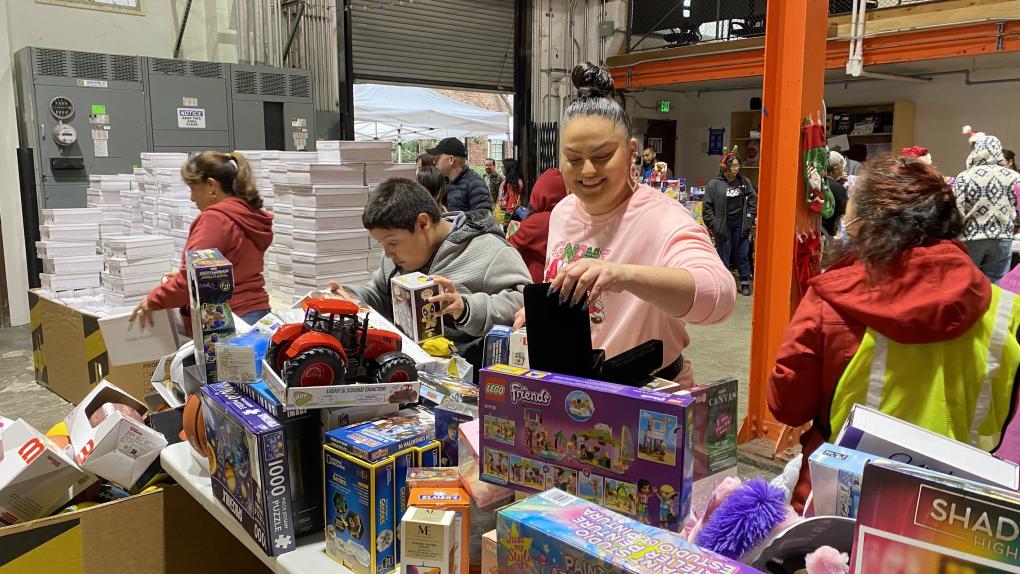
A photo from a previous year's toy giveaway at Mission Food Hub in San Francisco's Mission District.
During the pandemic, Marisol volunteered at Mission Food Hub, an opportunity that snowballed into her being hired as an ambassador for San Francisco’s Community Ambassadors Program, a safety and neighborhood engagement effort run by the city. CANA staff served as references.
"It’s not just me – my entire family has benefitted from CANA,” she said.
Marisol’s 14-year-old son, Emmanuel, is interested in business, so CANA gave him a space at 2024 Carnaval to sell soda, water, and chips. With the money he earned, he was able to purchase his own computer. Marisol said he cited CANA staff, including Rosine, in his recent school applications.
“I didn’t know that!” Rosine said through tears.
When CANA was founded by CEO Roberto Hernandez more than four decades ago, it was primarily an arts and cultural organization that sought to connect people to their Latino heritage and community. Since the pandemic, CANA has expanded that purview to include health in all its manifestations – mental, physical, financial, etc.
In February 2020, CANA pivoted after canceling Carnaval due to the onset of the pandemic. In those early months, COVID infections were concentrated among low-income Latino people with frontline jobs, who also experienced significantly higher mortality rates compared to other ethnic groups.
Roberto was scrambling to find a way to serve the community during the unprecedented and devastating time. The idea for the Mission Food Hub came to him a few weeks after an impactful phone call with a señora who was trying to apply for unemployment. The restaurant she worked for was paying her in cash, and since everything was off the books, she didn’t qualify for a scrap of governmental assistance.
So, Roberto asked her: “What’s the one thing I can help you with right now?” Her response: “Groceries.”

A photo from a previous year's toy giveaway at Mission Food Hub in San Francisco's Mission District.
In the days that followed, Roberto continued getting calls of that same ilk. The refrain: “We can't afford to buy groceries.”
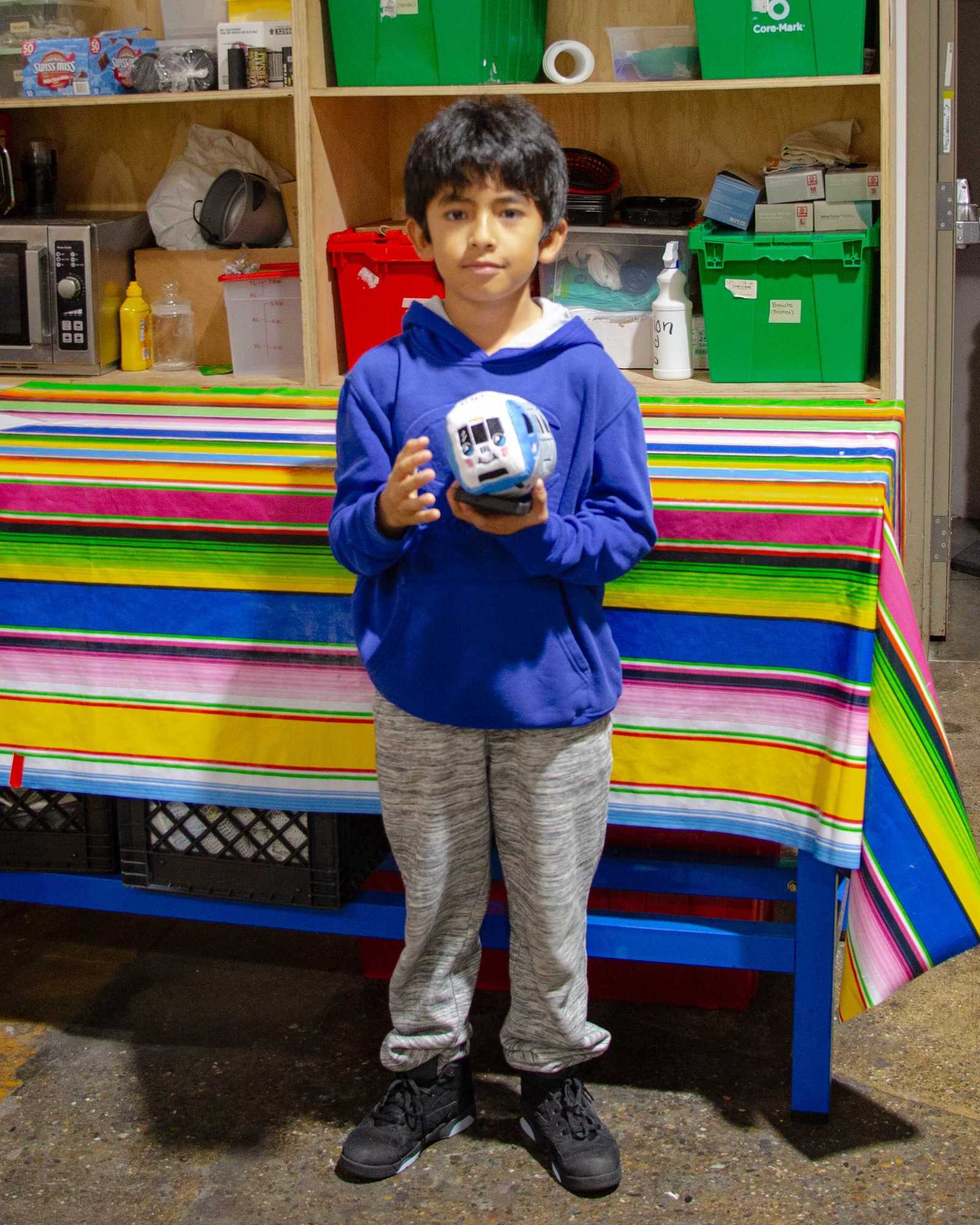
Roberto wanted to help as many people as he could, so he asked Carnaval sponsors if they could free up money from their festival contract to purchase food instead. Many obliged, and soon, dozens of pallets of food were headed to the ad hoc food bank Roberto was running from his garage.
There were so many incoming food donations – where would it all go?
Roberto started making calls and quickly struck a deal with the Mission Language and Vocational School on Alabama Street. They started with one school room, but quickly, the operation took over the building’s entire first floor. At the height of the pandemic, more than 9,000 families were picking up groceries from the food bank up to three times a week.
Mission Food Hub is still on that first floor, and it’s still serving up nutritious groceries to hundreds of families a week.
The umbrella organization, CANA, is growing too. Soon, it will open an Indigenous Peoples Cultural Arts Healing Center with the mission to preserve cultural roots and traditions for generations to come.
“Celebrating our cultural heritage is part of our healing mission, too,” Rosine said.
BART welcomes NBA All-Star Game by installing Next Generation Fare Gates at all downtown San Francisco stations
Just in time for the arrival of All Star weekend, BART has successfully installed new fare gates at all four of its downtown San Francisco stations. Riders who use Embarcadero, Montgomery, Powell Street, and Civic Center stations are now using the state-of-the-art gates that bring an entirely new look to BART and provide a boost for safety in the system.
“We’re excited to welcome visitors to BART in downtown San Francisco with these new fare gates that are helping to transform the rider experience,” said BART General Manager Bob Powers. “These gates are already proving to be an effective deterrent against fare evasion. The gates are not only boosting safety but they’re expanding access for people in wheelchairs and those who bring bikes or strollers to our system.”
The new gates feature clear swing barriers with a one-of-a-kind door locking mechanism to deter fare evasion. The gates include advanced 3D sensors that can detect if someone is in a wheelchair or has a bike, stroller, or luggage with them, allowing for more time before the swing barrier closes. They feature LED lighting on the swing barriers and pathway through the gate to help visually impaired riders.
“Getting Next Generation Fare Gates installed in time for All Star Weekend is a huge win for riders,” said Bay Area Council Chief Operating Officer John Grubb. “These four stations are gateways welcoming thousands of visitors from around the globe to downtown San Francisco. The gates give BART a whole new appearance and they’re providing a big boost for rider safety.”
BART has successfully installed new gates at 18 of its 50 stations. Full deployment systemwide will be completed by the end of 2025. Learn more about the project here. Riders can provide feedback about the new gates at bart.gov/comments.
BART's annual Holiday Toy Drive collects more than 1,500 toys and $1,700 in gift card donations

Left Image: A STEAM event with one of SCDC’s collaborative partners, "P.I.E.F.E.S.T." (Pacific Islanders Encouraging Fun, Engineering, Science & Technology). Right image: Participants from CYC’s Bayview Youth Advocates program work on an exercise of gratitude.
Update: The BART Holiday Toy Drive collected more than 1,500 toys and $1,700 in gift card donations this year. The toys were presented to the two recipient organizations, the Samoan Community Development Center of San Francisco (SCDC) and the Community Youth Center of San Francisco (CYC), during the December 21 meeting of the BART Board of Directors.
Each winter, BART gives back to the communities it serves with its annual Holiday Toy Drive, soliciting donations in the form of new, unwrapped toys and gift cards from employees. The donations are gifted to local organizations, selected by the BART Board President from within their district, in a joyful ceremony during the final BART Board meeting of each year.
Board President Janice Li selected two recipient organizations this year: the Samoan Community Development Center of San Francisco (SCDC) and the Community Youth Center of San Francisco (CYC).
“For immigrants like me, holiday time is community time. Growing up, it was important to me to have community spaces where I could speak my language, celebrate my culture, and be proud of my heritage,” Li said. “Organizations like CYC and SCDC are so critical to building welcoming and healthy communities"
She continued: “Both of these organizations have humble beginnings and have always been rooted in supporting youth and families in the community. I love that they believe in and know how to do transformational work, particularly for AAPI communities in the southeastern neighborhoods of San Francisco, where there are fewer resources and services available.”
BART’s Office of External Affairs and BART Police sponsor the drive each year. In 2022, BART collected more than 750 toys and $500 in gift cards for Building Opportunities for Self-Sufficiency.
“The Holiday Toy Drive is the highlight of the season for many BART employees. We are gratified to spread joy and cheer to local children and their families, many of whom rely on our system to get to school, to work, to appointments, and to gatherings with their families during the holidays,” said Rodd Lee, Assistant General Manager of External Affairs at BART. “It is a special honor to work with historic organizations like SCDC and CYC, who have long been committed to making the Bay Area a better place for our youth.”
SCDC and CYC support San Francisco youth with an incredible array of services, including afterschool programs, summer camps, mentorship programs, mental and physical health services, and enrichment activities. CYC was founded in San Francisco Chinatown in 1970 and serves youth across the city, aiming to provide them a sense of belonging as well as essential tools to succeed at school and in life. SCDC is located in the Visitacion Valley neighborhood of San Francisco, where it has worked for more than three decades to improve the quality of life for Samoans and Pacific Islanders in the Bay Area. It is the only funded organization in San Francisco that is devoted to supporting these populations.
Every single one of Treanna Noa’s seven children, ranging in ages from five to 21, has participated in SCDC’s programs.
“SCDC has opened so many doors for us. I don’t know where we would be without the center,” Noa said.
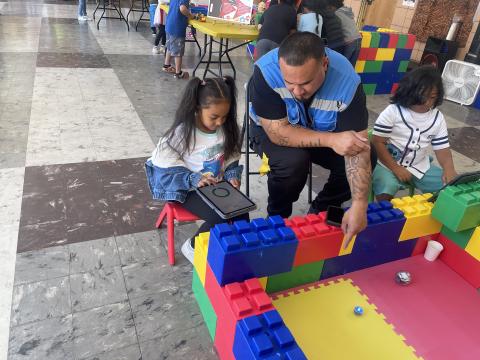

Top image: A STEAM event with one of SCDC’s collaborative partners, "P.I.E.F.E.S.T." (Pacific Islanders Encouraging Fun, Engineering, Science & Technology). Bottom image: A snapshot of SCDC’s PIYA Summer Celebration 2023.
SCDC “picks up where my kids’ schools are lacking,” she said. The children’s schools don’t have STEAM programs, for example, but every Wednesday, SCDC brings in a STEAM facilitator to teach kids about science and technology after school. The facilitator is a member of the Pacific Islander community, Noa said, and therefore understands the unique challenges her children experience in school and at home.
“My kids aren’t as open as they could be with their schoolteachers. They think, oh, you wouldn’t understand what I’m talking about; I’m Samoan, and we do things a bit differently,” she said. “Having someone who looks like you and who can relate to you, it brings your guard down and you’re more open to receiving information.”
Noa said SCDC even picks her younger children up from school, and the center provides them with a safe, supportive space where they can finish their homework until Noa gets off work. She said if SCDC didn’t exist, she wouldn’t be able to afford childcare.
“They do so much for us, including things we didn’t even ask for,” she said, like hosting drive-through graduations for her children when they finished high school and kindergarten during the pandemic.
“They have made life so much easier for us,” she said.
Susan Tan’s son, Ben, began attending CYC's afterschool program when he was in middle school. She credits the organization with helping him become the person he is today.
Ben was a preteen when he and his mother immigrated to San Francisco from China. They didn’t know English very well and assimilating was difficult. Ben struggled in school, behaviorally and academically, and his mother recognized his struggles as “a cry for help.”

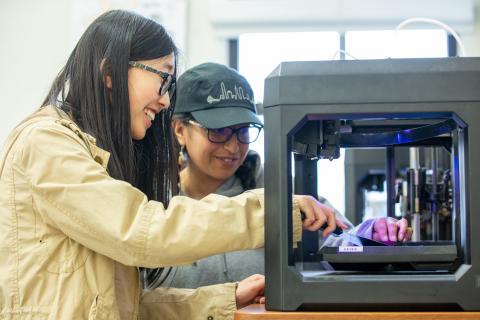
Top image: Erica Mitchell works with a student from Redding Elementary on academics at CYC’s afterschool program. Bottom image: Stefanie Almendares works with a student from Aptos Middle School during a 3D printing workshop as part of CYC’s STEM program.
“I reached out to everyone I knew to see if anyone could help, and CYC was one of the names that came up,” Tan said, speaking through a translator. She took a parenting class first, where she learned to be more patient and communicative, and then enrolled Ben in CYC's afterschool program. In the span of just two or three years, she said she saw him blossom and transform.
“It became a second home for him. I was working so much, and there was nowhere for him to go after school,” she said. At CYC, she knew Ben was safe.
Today, Ben is studying math and computer science at the University of California at Santa Cruz. Last summer while home from school, he participated in CYC’s transitional-age-youth program.
Administrators at CYC and SCDC said they are honored to be this year’s BART Holiday Toy Drive recipients. They emphasized the toys will immensely brighten their youth participants’ holidays. The organizations will receive the toy donations during the December 21 BART Board meeting at BART Headquarters.
“The majority of our youth come from low-income families, and they don’t necessarily have the means to give their kids many presents, if any presents. To provide families with something as simple as a toy can have a profound impact,” said Ben Mok, CYC Community Relations Manager.
Michelle Wu, a communications consultant for CYC, added: “One of the things we believe in the most is providing access to things, including providing access to moments of joy.” The toys from the drive will specifically go to youth at CYC’s Bayview program.
Lynn Peleseuma, Senior Program Specialist at SCDC, said her organization hosts a holiday celebration every winter before the kids start winter break. There’s caroling, cultural dancing, and festive food and drink. At the gathering, Peleseuma and her colleagues “want to make sure each and every kid has a toy to unwrap.”
“To get toys from BART, from folks in our community, is a blessing for us,” she said. “And it’s a blessing to our kids and their parents.”
If you are a member of the public interested in gifting a donation to SCDC or CYC, you can visit their websites here and here.
BART's low-income fare discount to increase to 50% on Jan. 1: Here's how the program impacts an East Oakland community
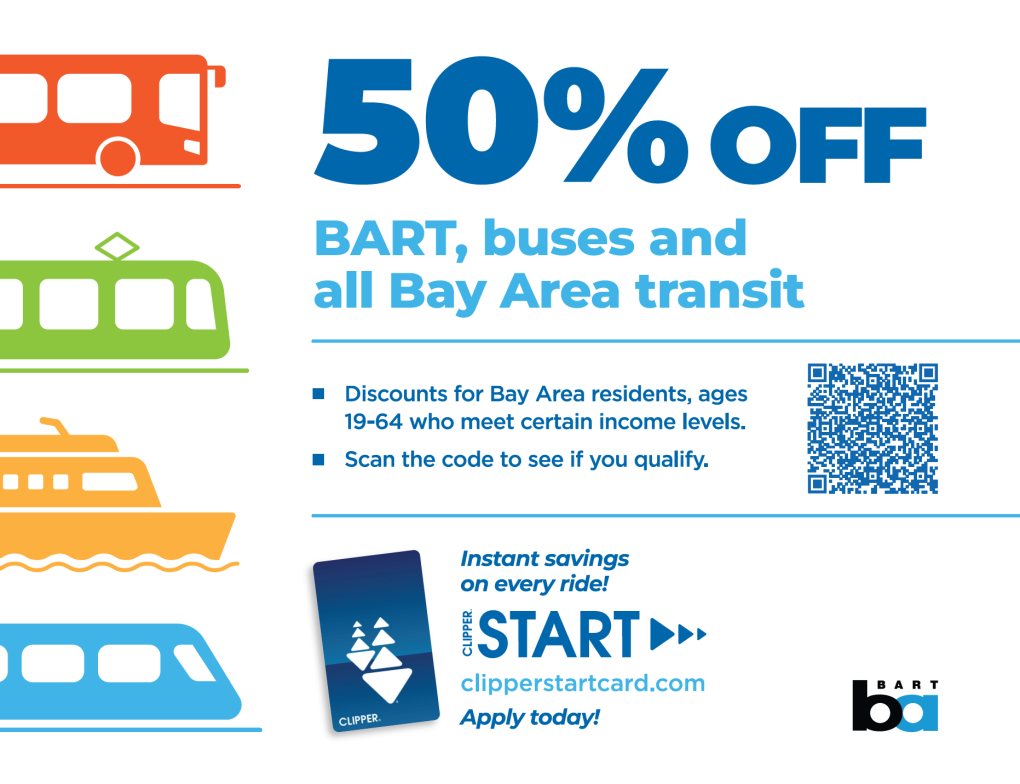
BART is helping lower-income riders pay their fare by increasing its Clipper START means-based fare discount from 20% to 50%, beginning Monday, Jan. 1, 2024. This means that Clipper START users will pay half the regular BART fare.
Clipper START, a pilot program facilitated by the Metropolitan Transportation Commission, offers the discount for Bay Area residents ages 19 to 64 whose incomes are less than 200% of the federal poverty level. Clipper START is accepted by more than 20 regional transit operators. Those who qualify can apply for the program here.
Keep scrolling to read about an East Oakland-based organization's efforts to register people for Clipper START and hear about its impact on community members.
BART offers multiple fare discounts in addition to Clipper START, including discounts for youth (50% off with a Youth Clipper card), seniors (62.5% off with a Senior Clipper card), passengers under 65 with qualifying disabilities (62.5% off with an RTC Clipper card), and a High-Value Discount (adult Clipper users who buy $45 or $60 Clipper cards when autoload is set up get $48 and $64 worth of value, or a 6.25% discount).
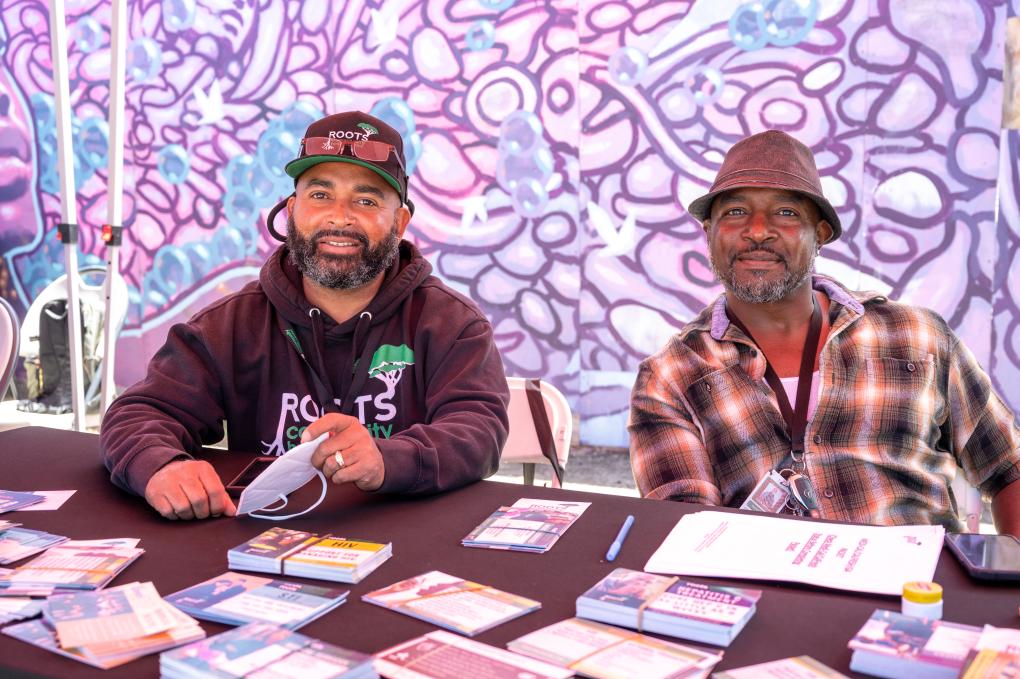
Members of the Roots Community Health Center outreach team. Roots conducts outreach to promote and register community members for Clipper START.
“When you have a Clipper card, your first thought isn’t 'I can't' but ‘What time can I get there?’” says Jamaica Sowell, who has witnessed firsthand the importance of increasing access to affordable transportation in the Bay Area.
Sowell is the Director of Programs and Policy at Roots Community Health Center, an organization working to uplift people impacted by systemic inequities and poverty, especially in a stretch of the East Oakland community known as the 40x40, where nearly half of Black families living in poverty in Oakland reside.
Since 2022, Roots has been conducting outreach to promote and register community members for Clipper START, a pilot program from the Metropolitan Transportation Commission (MTC) that offers discounts on transit fares. To qualify, applicants must be Bay Area residents between the ages 19 and 64 with a gross annual income at or below 200% of the federal poverty level. Beginning January 1, 2024, BART’s Clipper START discount increased from 20% to 50%, meaning users pay half the regular BART fare.
Roots Clinic has a holistic approach for supporting the health and well-being of the communities it serves. Enabling access to transportation, especially affordable transportation, is a key piece of the puzzle.
“Mobility has a lot to do with access, including things like health care,” said Sowell. If people don’t have the means to get to the Roots’ clinics, “they’re not going to come.”
Mobility is a central component of one's physical and mental health, Sowell stressed. Transportation, especially affordable transportation, ensures that people can access things like medical appointments, mental health care, treatment programs, benefits enrollment support, and other crucial services that organizations like Roots offer.
But going to appointments is "just one facet” of the benefits of public transportation to community members, Sowell said. Transportation gives people easier access to civic engagement activities, like city council meetings, and takes people to parks and green spaces, where you can walk, soak up sunshine, picnic with your family, and play sports with friends. For some people, just getting out of their neighborhood for a few hours is healing in and of itself.
“Transit takes you places outside your own block, including places you might not have had access to before,” Sowell said.
Clipper START actively conducts outreach to organizations like Roots, which have well-established lines of communication and trust within the communities they serve. Sowell said Roots jumped at the chance to partner with MTC on Clipper START because her organization understands the specific needs of the East Oakland community.
“When our people hear Roots is partnering with MTC and BART, it automatically establishes buy-in,” she said. “Our community members trust us and trust that we’ve vetted the program.”
Since Clipper START launched in June 2020, MTC reports that more than 30,000 people have signed up for the program. Between 2020 and 2022, the period for which the most recent data is available from MTC, Clipper START users took more than 1 million transit trips, with most of these trips taken on BART (40% of total trips).
“[Clipper START] makes me want to do more [with my family] on public transportation for necessity, but also for fun, like going to San Francisco for free museum days,” one user said.
As awareness of the program grows around the region, so too does usage.
That’s in no small part thanks to organizations like Roots, whose outreach teams promote the program at community events, apartment complexes, encampments, faith-based organizations, and door to door. Roots is exploring additional outreach avenues for the new year.
“Being able to tap into a discounted transportation platform like this is huge for our folks,” Sowell said. “Clipper START has been beneficial in improving transportation accessibility to our East Oakland community, and we look forward to our continued partnership in the new year.”
“Our systems are more aligned now than ever”: Local transit CEOs take BART, buses, and even an electric trolley during Earth Day ride-along event
Ride-along attendees and transit riders fill a County Connection Route 14 bus. On Friday, April 21, ten transit CEOs from across the Bay Area gathered for a multimodal, three-hour-long voyage that carried them from the green hills of Orinda to the dry heat of Pittsburg. The “All Aboard with Transit CEOs”
Holiday schedule: BART will run Sunday service (8am-midnight) on Christmas Day and extended service on NYE (5am-1am)
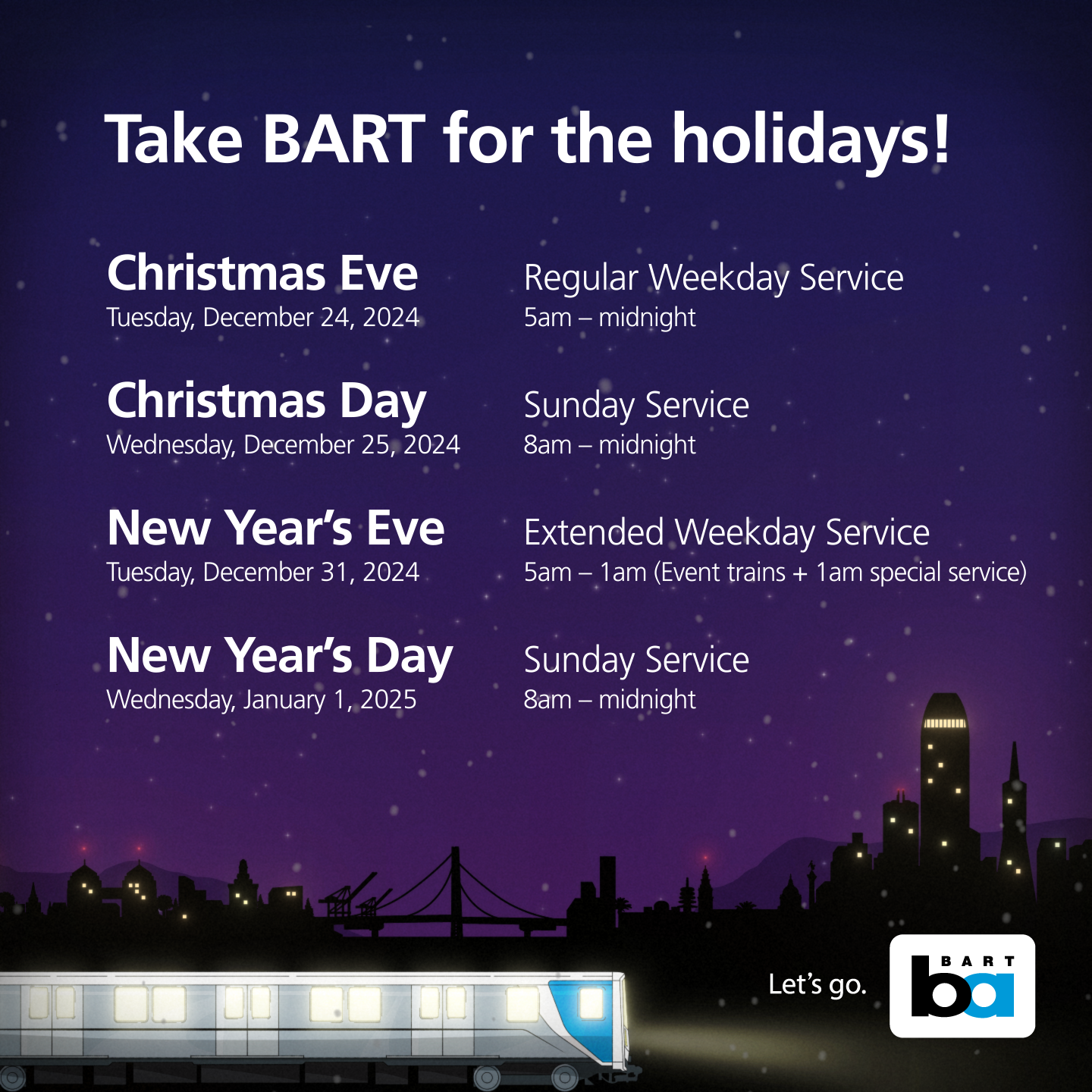
BART will be running special service on Christmas Day, New Year's Eve, and New Year's Day. Plan your trip using BART's Trip Planner.
Holiday Schedule
Christmas Eve, Tuesday, December 24: Regular weekday service (5am-midnight)
Christmas Day, Wednesday, December 25: Sunday service (8am-midnight)
New Year's Eve, Tuesday, December 31: Regular weekday service (5am opening) with extended late-night service, extra staffing, and additional event trains as needed. BART will be providing extended service until 1am for late-night riders coming back from fireworks shows and celebrations. More on this below.
New Year's Day, Wednesday, January 1: Sunday service (8am-midnight)
New Year's Eve 1am Extended Service - More Info
Our 1am extended service will be as follows:
- Three-line special service (Yellow, Blue and Orange only in both directions, for total of six trains for 1am extended service). Yellow Line will be the only line running in San Francisco and Peninsula. Blue Line will run between Bay Fair and Dublin/Pleasanton.
- Trains will be waiting at MacArthur and Bay Fair to complete timed transfers.
- Yellow Line and Orange Line trains in all directions will be timed to meet at MacArthur Station at 1:47am in a "grand meet." This is the transfer point for riders coming from San Francisco heading toward Richmond or Berryessa or riders coming from the East Bay heading toward San Francisco.
- Orange Line and Blue Line trains will be timed to meet at Bay Fair Station at 2:16am. Dublin-bound riders can take the Berryessa-bound Orange Line train and transfer at Bay Fair Station.
- SFO and OAK airport stations will NOT be served.
- Last East Bay-bound train running through downtown San Francisco will be at around 1:30am.
- Last southbound train heading toward Millbrae will run through downtown San Francisco at 2:10am.
- The regular last trains of the evening (Yellow, Blue, and Orange lines) will be dispatched from the end of their lines at midnight and then at 1:00am, we will run another set of last trains of the evening to serve 48 out of our 50 stations. The 1am trains will not serve SFO and OAK airport stations.
BART’s Trip Planner has been updated to include the extended service trains.
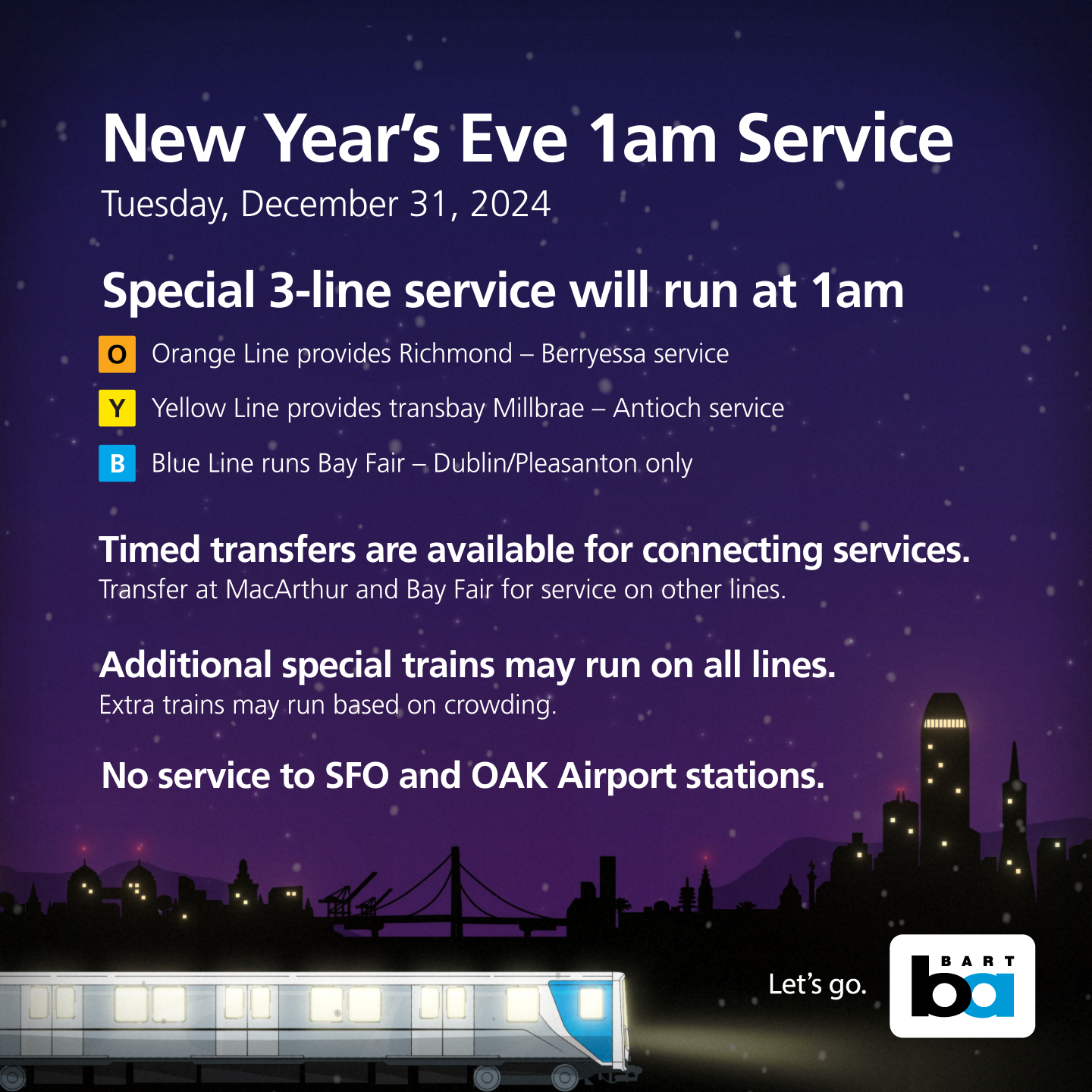
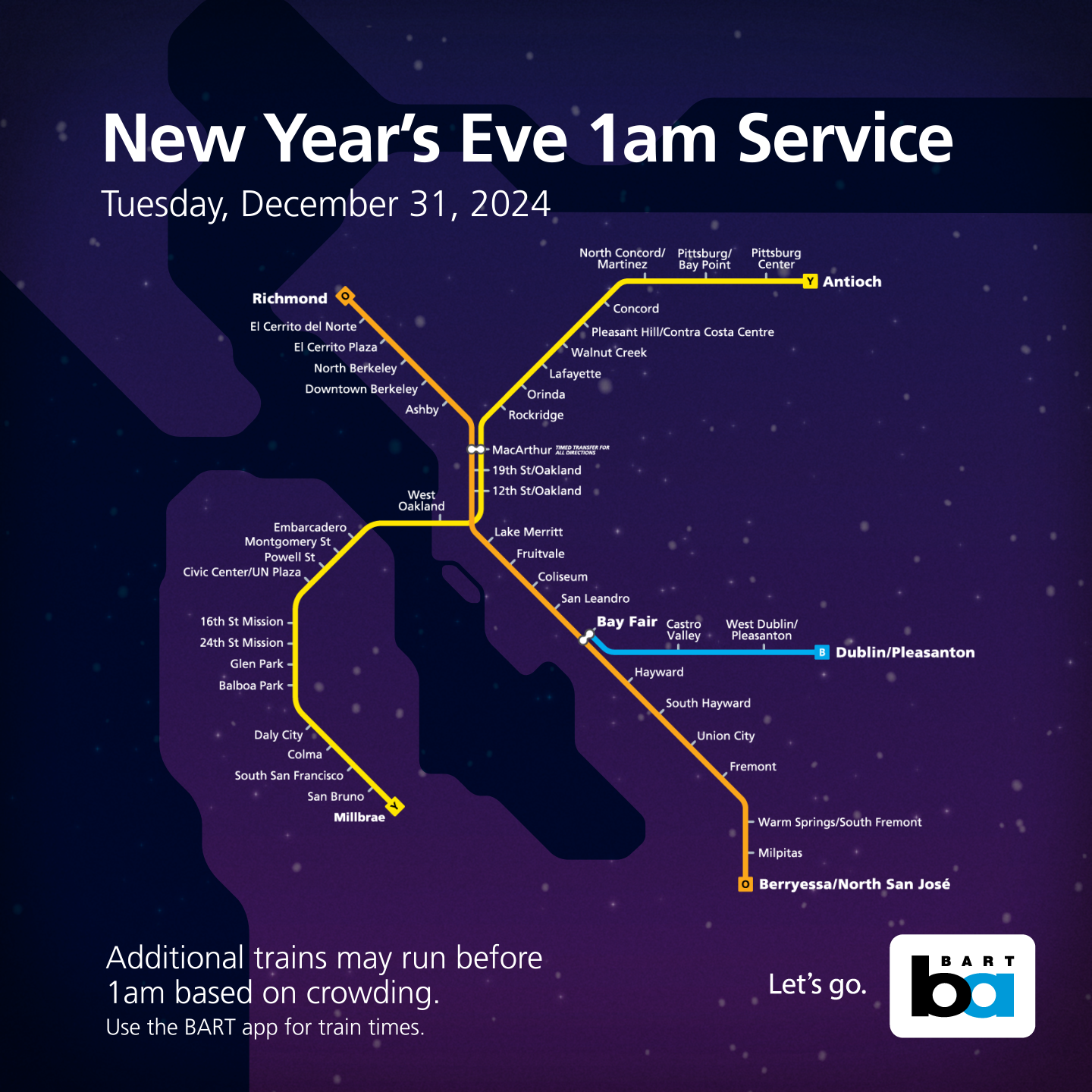
Parking at BART on Holidays
Parking is always free after 3pm and on weekends. Parking will also be free on Christmas Day and New Year's Day. This applies to all BART stations except for Milpitas and Berryessa/North San Jose, as they are operated by VTA.
All other parking rules will be enforced.
Parking at BART for Holiday Travel
Airport parking can be a hassle and is always expensive, except at BART stations. We offer inexpensive multi-day parking (see options below) at many stations with easy online reservations. Purchase parking on the Official BART App or pay by website.
To accommodate the increased demand for Reserved Parking at Millbrae Station during the holidays, Reserved Parking is allowed on any level of the garage for reservations with a start date between December 23, 2024 – January 10, 2025. Reserved Parking at San Bruno Station is also allowed on all levels of the garage during the holiday season.
Single/Multi-Day Reserved parking is for consecutive overnight stays of up to 20 weekdays. You will need to provide the license plate of the car you plan to drive and a phone number. Reference our guide for paying for Single/Multi-Day Reserved parking here.
Monthly Reserved parking is for stays of up to 24 hours at a time, charged on a recurring monthly basis, and provides a guaranteed space until 10am. This is not to be used while travelling for several days in a row.
Reserved parking signs are blue + white or yellow. During the holidays we experience a higher demand in Reserved parking; if there is not a reserved spot available when you arrive, park in the Daily Fee area and you will not be cited. Daily Fee parking is only allowed in the Daily Fee area.
Find an overview of parking at BART at bart.gov/parking.
Taking BART to SFO or OAK
Traveling by plane for the holiday? It’s easy to ride BART to the airport. You can take the train directly to San Francisco International Airport (SFO) and Oakland International Airport (OAK). Plan your trip and find fares by using BART’s online Trip Planner and read our comprehensive guide on riding BART to the airport.
Another option for travel to SFO via BART is to purchase Multi-Day Reserved parking on the Official BART App or website and drive to Millbrae Station or San Bruno Station, then take a quick ride to SFO Airport.
Stay Safe
Save these numbers in your phone:
- 510-200-0992 to text BART Police dispatch to discreetly report criminal activity
- 510-464-7000 to call BART Police in an emergency (It’s faster than calling 911)
We also offer the BART Watch App--a free mobile app available on the App Store and Google Play that allows you to quickly and discreetly report criminal or suspicious activity directly to BART Police.
You can reach the Train Operator using call buttons in each car located by the side doors on the new trains.
Note your train car number when contacting police or the Train Operator. The train number is located above the doors on the inside of each end of the train car.
BART will have extra safety staff working on New Year’s Eve.
Holiday Fun
BART’s customer satisfaction rate has hit its highest mark in ten years, rising six percentage points in two years
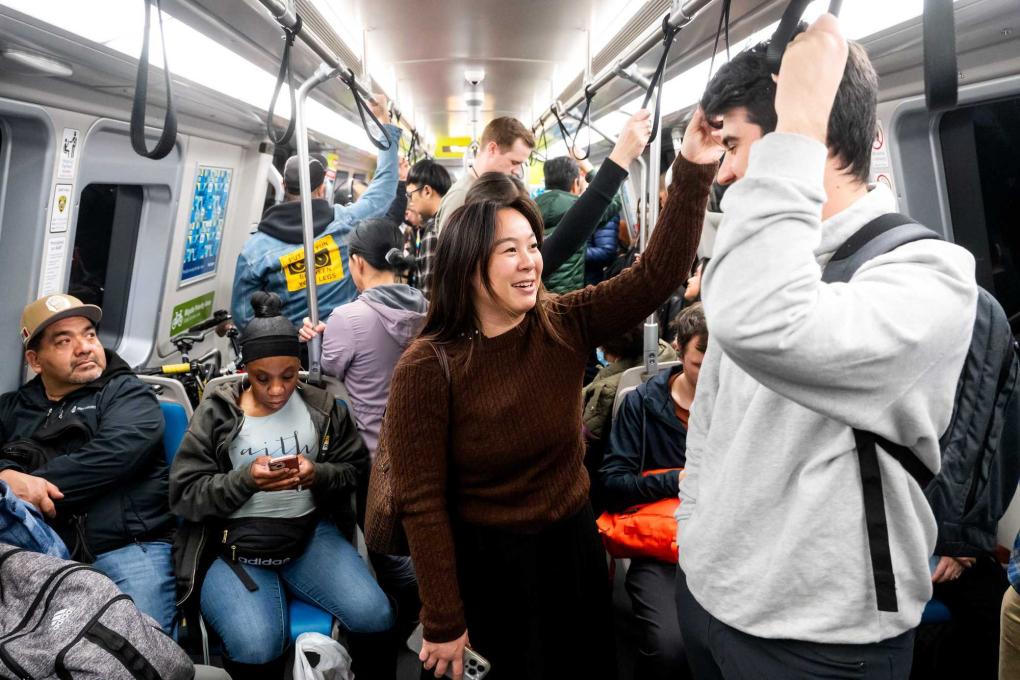
BART’s customer satisfaction rate has hit its highest mark in ten years and surged six percentage points in two years according to the latest comprehensive biannual survey of BART riders.
The 2024 BART Customer Satisfaction Survey found that 73 percent of respondents are “very or somewhat satisfied with BART” compared to 67 percent of those questioned in 2022, the last time BART conducted the survey.
In addition to general questions, respondents were also asked to rate 24 service attributes on a scale of one to seven. Ratings for 17 of the 24 metrics improved in 2024. Cleanliness of trains and stations, on-time performance, presence of BART police, personal security, enforcement against fare evasion, and addressing homelessness all showed improvement.
“These results confirm our Safe and Clean Plan is transforming the BART experience and making our system cleaner and safer,” said BART Board President Mark Foley. “We recognize there is still room for improvement; however, our focus on enhancing the customer experience is yielding positive results. It’s encouraging to see the survey responses that echo what I’m hearing from riders as I travel through the system.”
Some other findings:
- 80 percent of those surveyed said they would recommend BART to a friend or out-of-town guest, up four percentage points from 2022.
- 67 percent agree that BART is a good value for the money, up three percentage points.
- The average rating for train interior cleanliness increased by a whopping 14 percent.
- The average rating for station cleanliness increased by eight percent.
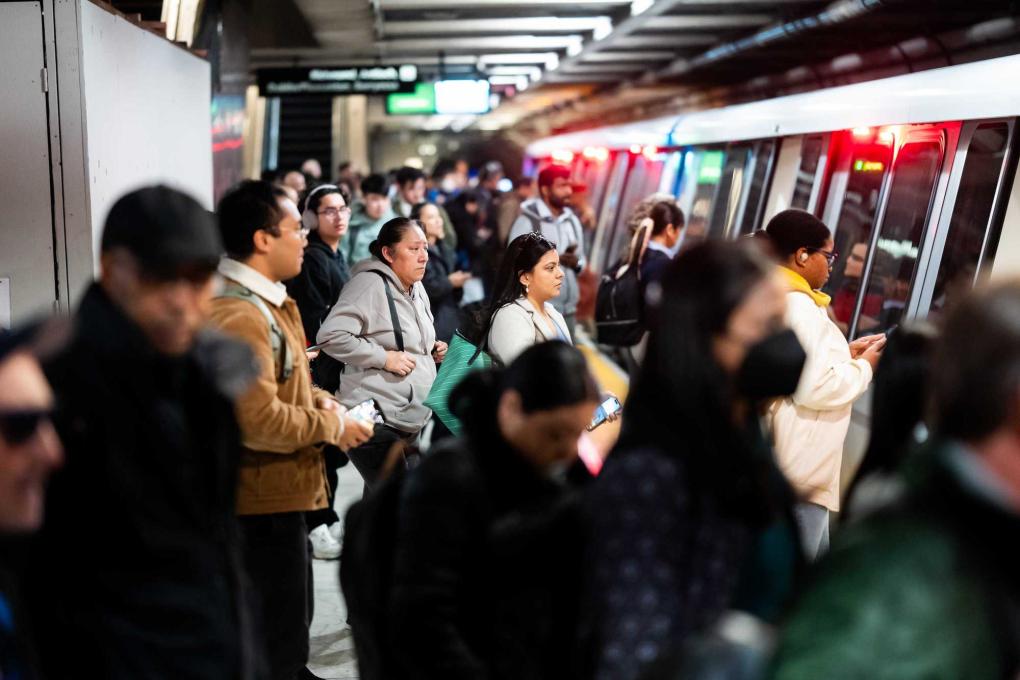
Only the availability of space on trains for luggage, bicycles and strollers and availability of seats on trains declined, unsurprising given the increase in overall ridership since 2022 and BART’s move to run shorter trains to enhance safety and save on energy costs.
BART has surveyed its riders every two years since 1996. More than 4,600 questionnaires in English, Spanish and Chinese were distributed onboard a representative sample of train runs last autumn.
The survey results were presented to the BART Board of Directors at its annual Board Workshop, Thursday, February 27, 2025. View the full presentation here.
BART also asks about customer satisfaction in its ongoing Passenger Environment Survey. That survey is about a rider’s specific trip. The latest customer satisfaction rate from that survey is 83%.
